Qolsys IQ Panel 2 & 2 Plus 2.5.0 Install Guide - Dated 03/30/20
Related Products


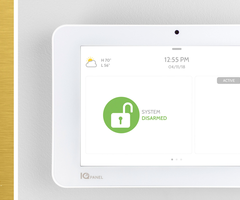

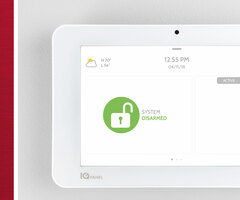

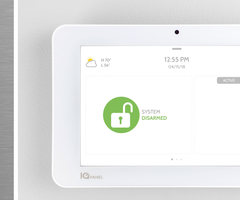
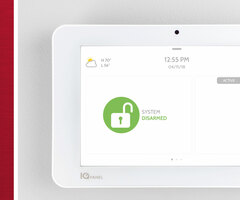
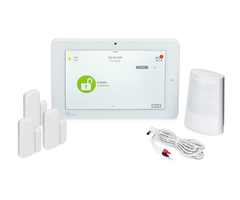

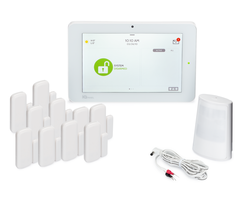
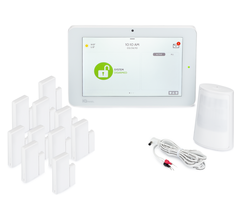
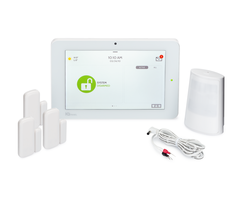
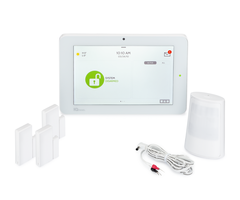
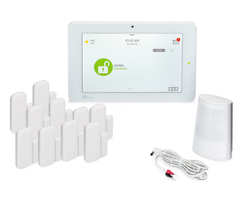
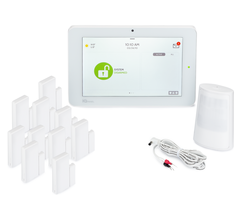
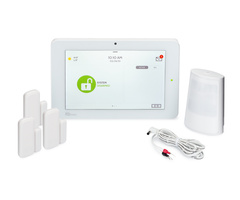
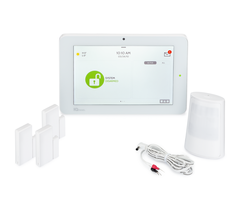
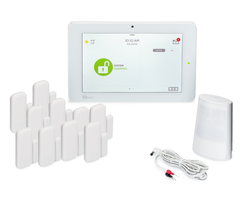
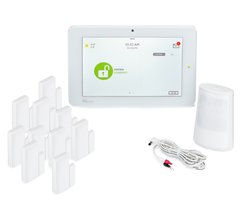
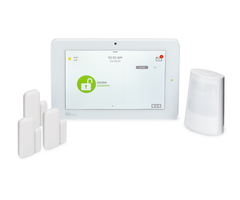
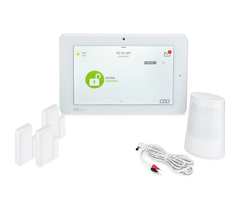
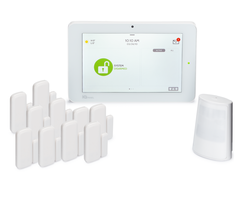
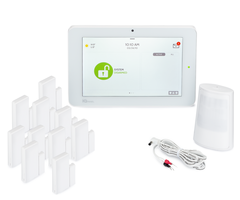
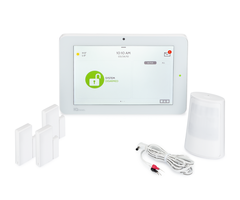


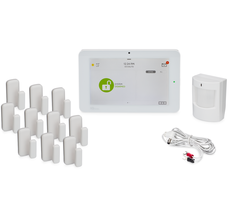
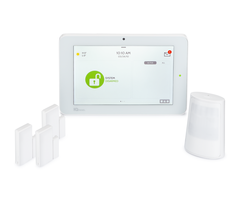
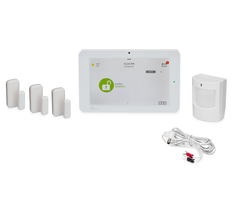
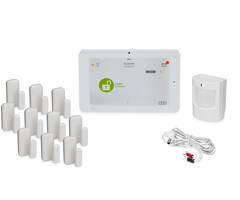

Related Categories
- Wireless Touchscreen Alarm Panels
- Small Business Security Systems
- Monitored Home Security Systems
- Apartment Security Systems
Document Transcript
The Qolsys IQ Panel 2 & IQ Panel 2+ is a 7” touchscreen built with an Android operating
system, providing full security and smart home functionality in an easy to use interface.
INSTALLATION MANUAL
Qolsys IQ Panel 2/2+
Software Version 2.5.0 INTRODUCTION
ABOUT THIS GUIDE
QOLSYS CONFIDENTIAL AND PROPRIETARY
PAGE
OF
2
177
?
QUESTIONS?
Contact us at
techsupport@qolsys.com
This document outlines the basic hardware specifications and software directions to
install and customize the IQ Panel 2 & IQ Panel 2+. Note that the information
presented is not comprehensive, but is specifically dedicated to those menus,
features, and systems accessible solely to those with the proper installation code.
Features accessible to users and installers alike are outlined in the IQ Panel 2 User
Guide. The information contained is confidential and proprietary, and is solely owned
by Qolsys Inc. Any reproduction, modification or distribution without permission is
strictly prohibited.
IQ Panel 2/2+
Power
Supply
Table
Stand
INCLUDED IN BOX
SUPPORT TABLE OF CONTENTS
PANEL OVERVIEW
5- Exterior Front
6- Exterior Back
7- Interior
INSTALLING THE PANEL
9- Wall Mount Option
10- Table Stand Option
11- Wiring Diagram
12- Powering the Panel
USER INTERFACE
14- Home Screen Overview
15- Message Center
16- Settings Tray
PROGRAMMING
18- Screen Lock
19- Settings
21- Advanced Settings
22- Setup Wizard
26- Installation
28- Installer/Dealer Settings
36- System Logs
37- Siren and Alarms
39- Security and Arming
42- Camera Settings
44- Z-Wave Device List
45- Sound
49- Partitions
50- Local Automation
SECURITY SENSORS
53- Security Sensors
54- Auto Learn Sensor
55- Add Sensor
56- Scan QR Code
57- Partition Name
58- Sensor Type
59- Sensor Groups
74- Sensor Name
76- Chime Type
77- Voice Prompts
78- Source
79- Edit Sensor
80- Delete Sensor
81- Sensor Status
83- Panel Motion Settings
WI-FI DEVICES
85- Wi-Fi Devices
87- Access Point Settings
88- AP Connected Devices
89- IQ Remote Devices
90- 3rd Party Connections
Z-WAVE™ DEVICES
92- Z-Wave Devices
93- Add Device
94- Clear Device
95- Delete Failed Device
96- Remove All Devices
97- View/Edit Associations
98- Z-Wave Settings
100- SmartStart
101- Provisioning List
BLUETOOTH DEVICES
103
-
Bluetooth Devices
104- Add Device
105- Edit Device
106- Delete Device
107- Remove All Devices
108- Settings
109- Add Speaker
SYSTEM TESTS
111- System Tests
113- Wi-Fi Test
114- Sensor Test
118- Cellular Test
119- Image Sensor Config
120- Z-Wave Test
121- Rediscover Network
122- Neighbor Info
123- Counters
125- Z-Wave Diagnostics
126- Advanced Z-Wave Diag
127- PowerG Test
128- Zigbee Test
129- Panel Glass Break Test
132- Dual Path Test
133- Daughter Cards Test
134- Panel Test
CUSTOMIZATION
136- User Management
137- Dealer Branding
138- Contact Info
139- Load Custom Logo
140- On-Screen Billboard
141- Load Help Videos
142- Connecting to Wi-Fi
143- Weather
144- Photo Frame
147- Load Images from SD Card
MAINTENANCE
149- Upgrade Software
150- Upgrade Software Using Wi-Fi
151- Software Update Via SD Card
152- Automatic Background Check
153- Battery Replacement
TROUBLESHOOTING
155- About
158- Power Down
159- Panel Reboot
160- Hard Reboot
161- Panel Test Troubleshooting
163- Cannot Load Help Videos
LEGAL
165- Important Information
SPECIFICATIONS
173- Specifications
175- Supported S-Line Sensors
176- Supported PowerG Sensors PANEL
OVERVIEW
Warning: This Product should be installed in accordance with the National Fire Alarm Code, ANSI/NFPA 72, (National Fire Protection Association,
Batterymarch Park,Quincy, MA 02269) and with National Electric Code, ANSI/NFPA 70. Printed information describing proper installation, operation,
testing, maintenance, evacuation planning, and repair service is to be provided with this Product. In Canada the product shall be installed in accordance with
the Standard for the Installation of Residential Fire Warning Systems, CAN/ULC-S540.
Warning: For Canadian installations this Product and all sensors associated with it (collectively, the “System”) should be tested once a week. The test shall be
performed also with primary DC power de-energized. For recommended smoke detectors maintenance instructions refer to user manual associated with
compatible Qolsys model QS5110-P840 smoke detector. PANEL OVERVIEW
EXTERIOR FRONT
QOLSYS CONFIDENTIAL AND PROPRIETARY
PAGE
OF
5
177
Panel Camera
User Interface
Microphones
LED Status Light
Page Indicator PANEL OVERVIEW
EXTERIOR BACK
Optional locking
screws for table
mount
Mounting holes
single, double or
triple “gang” box
compatible
Micro SD
Card Slot
Speaker
Rear Access Cover
Siren
QOLSYS CONFIDENTIAL AND PROPRIETARY
PAGE
OF
6
177
Speaker
Microphone
Microphone
Optional locking
screw for wall mount
RF Antenna
routing hole
For UL1610 applications
this screw shall be used
for tamper protection
against mounting removal PANEL OVERVIEW
INTERIOR
Panel Battery*
Z-Wave Plus™
Radio
LTE Sim Card
“Tool-less”
Terminal Block
Tamper Switch
Cellular Antenna
The battery should NEVER be disconnected without following proper power-down procedures
Failure to comply may result in data corruption, panel failure, and a void of the manufacturer's warranty
*CAUTION
QOLSYS CONFIDENTIAL AND PROPRIETARY
PAGE
OF
7
177
Siren
Security
RF Radio
(319.5 MHz, 345 MHz or 433 MHz)
Barrel Jack
Power
PowerG
or
Image Sensor Antenna
Expansion Slot
PowerG or Image
Sensor Radio
(PowerG Radio is
Standard
on IQ Panel
2+. PowerG modem is required for
UL1610 compliant installations
Image Sensor Radio is
Optional
and
not available for use on IQ Panel 2+
with PowerG) INSTALLING
THE PANEL
INSTALLING THE PANEL
1. Insert your thumb or
finger under the opening on
the back cover and firmly
pull up to remove. This
cover is not needed for wall
mount.
2. Press tabs on the bottom
of the panel and pull apart
to remove the back plate.
Mount to the wall using
appropriate hardware
ensuring it is level.
1. Hang the front of the panel
with the hanging strap on the
back plate as shown above.
2. Using the provided hole in the
lower right hand side of the
backplate as a template, drill a
1/4” hole in the wall and feed the
white RF antenna into the wall.
3. Screw required in break-away
wall tamper for UL 1610
IMPORTANT
: Not properly
routing the RF antenna in the
wall will greatly reduce RF sensor
range.
Firmly pinch “
diagonally and
down
” from the top front of
the bezel at all 4 snap tab
locations to ensure proper
closure. You will hear a “pop”
or “snap” sound when each
tab has closed properly and
the gap along the top should
be tightly seated.
IMPORTANT
: Not properly
closing the panel could result
in damage to the backplate
or false panel tampers.
WALL MOUNT OPTION
Connect the power supply to
the barrel jack or to the (+/
Red) and (-/Black) terminals if
using a custom length wire.
1. Latch the bottom of the
panel into place, ensuring the
the RF antenna and power
wire are routed into the wall
and not pinched.
2. Swing the panel up towards
the 4 snap tabs at the top.
1
2
1
2
1
2
3
Note: For UL Commercial Burg installations (UL1610 compliant) use only wall mount option INSTALLING THE PANEL
1. With the included power
supply and cable, plug the
barrel connector into the
jack next to the terminals as
shown above.
2. Route the cable under the
hook next to the battery.
3. Route the cable through
the strain relief opening.
Replace the cover by
inserting the top first, then
while making sure the
cable passes under the
opening firmly press down
on the bottom until the
cover “snaps” into place.
QOLSYS CONFIDENTIAL AND PROPRIETARY
PAGE
OF
10
177
TABLE STAND OPTION
Insert your thumb or finger
under the opening on the
back cover and firmly pull
up to remove.
1
2
3
Insert table stand dowels
into the 2 upper keyholes.
Slide the stand firmly
upwards until you hear a
“click” from each side. INSTALLING THE PANEL
WIRING DIAGRAM
QOLSYS CONFIDENTIAL AND PROPRIETARY
PAGE
OF
11
177
NOTE: Use only UL/ cUL listed external
siren in UL/cUL listed installations.
Rating:12vDC/300mA
NOTE: Inputs are used only for residential
Burglary applications. SENSOR 1, 2 & EXT
SIREN are not permissible in UL1610
installations.
IMPORTANT
IF USING CUSTOM LENGTH
WIRE:
- 5.5vDC Transformer: Use 18AWG wire
no longer than 25ft to ensure sufficient
power is received at the panel.
- 7vDC Transformer: Use 18AWG wire no
longer than 100ft to ensure sufficient
power is received at the panel.
* The minimum permissible wire size shall
not be smaller than 22 AWG
** A 7vDC power supply is only supported
on panels with hardware revision E or
newer.
NOTES
5vDC to 7vDC* IN
GND
SENSOR 1
GND
SENSOR 2
GND
EXT SIREN
GND
**WARNING! Use 5vDC to
7vDC** Power Supply ONLY
4.7k EOL
CLOSED LOOP
CIRCUIT
-
+
EXT SIREN:
Maximum Voltage: 12vDC
Maximum Current: 300mA
5vDC to 7vDC** IN
BARREL JACK
BARREL JACK FOR
USE WITH SUPPLIED
BARREL CONNECTOR
CABLE ONLY.
STRIPED WIRE IS
POSITIVE (+)
4.7k EOL
Input rating: 100-240vAC, 50/60Hz, 0.2A
Output rating: 5.0 - 7.0vDC, 1.0A
Model SW-055100A or SW-050100A or
SW-070100AB INSTALLING THE PANEL
QOLSYS CONFIDENTIAL AND PROPRIETARY
PAGE
OF
12
177
Press and hold the power button on
the right side of the panel for 3
seconds to power up.
POWERING THE PANEL
Connect power supply.
WARNING! Use a 5vDC to 7vDC Power Supply ONLY
If using the provided cable, the “striped” wire is (+)
Note: Power supply shall be located within same room as control unit USER
INTERFACE USER INTERFACE
Header &
Settings Tray
Primary User
Interface &
Partition
The home screen is divided into three sections. The header shows the date & time, today’s weather, message center and
the Settings tray. The Primary interface shows arming options and sensor status & partition select. The footer shows panic
options and additional pages.
QOLSYS CONFIDENTIAL AND PROPRIETARY
PAGE
OF
14
177
Page
Indication and
Emergency
HOME SCREEN OVERVIEW The header contains the the pull down settings tray, the weather icon, time/date and a message icon in the
upper right portion of the screen where you will find Security Provider messages and contact info, alerts,
video tutorials and FAQ’s
USER INTERFACE
QOLSYS CONFIDENTIAL AND PROPRIETARY
PAGE
OF
15
177
This is where you will find the Security Provider’s Contact Information
This is where you will find Video Tutorials to help with common questions
This is where you will find messages from the Security Provider, Panel
Alerts and Alarm Notifications.
MESSAGE CENTER USER INTERFACE
SETTINGS TRAY
QOLSYS CONFIDENTIAL AND PROPRIETARY
PAGE
OF
16
177
To access the Settings tray swipe down on the bar at the top of the screen. The
Settings tray has quick access to system, battery, Wi-Fi, bluetooth & cellular status as
well as volume control, brightness, a lock screen icon and other quick settings.
Swipe down
for access
FIND IT
When partitions are
DISABLED, a Status
icon resides in the
upper left corner of
the settings tray.
Touch this icon to
return to the security
page.
When partitions are
ENABLED, a Lock
Screen icon replaces
the Status icon.
Touch this icon to
switch between
partitions. PROGRAMMING When the “Screen Lock” or “Partitions” setting are enabled, a lock screen will be presented once the panel has been woken
from either a touch on the screen or pressing the wake/sleep button on the side of the panel. This prevents unauthorized
access to the panel and/or one partition from accessing another as well as managing permissions to “Advanced Settings”.
PROGRAMMING
SCREEN LOCK
4 DIGIT SCREEN LOCK
6 DIGIT SCREEN LOCK
QOLSYS CONFIDENTIAL AND PROPRIETARY
PAGE
OF
18
177 The Settings page allows quick access to various simple
features & settings that do not require the protection of a
Dealer, Installer or Master code to be changed.
PROGRAMMING
FIND IT
Swipe down
for access
SETTINGS
SETTINGS
Setting
Description
Display
Adjust brightness, font size & 12/24 hour time
SD Card
Mount, unmount and manage SD Cards that are installed in a panel
Weather Temperature
Toggle between Farenheight and Celcius
Status
View the "Current Status" of security sensors: Zone #, Name, Status
(Open, Close, Active, Idle, Tamper, Failure), Battery and sensor History. Also
view “Alarms” and “History” for security sensors globally
Z-Wave™ Device Status
View the "Current Status" of Z-Wave devices: Name, Type, Status (Normal,
Failure), and Battery. Also view “Alerts” and “History” for Z-Wave globally
Other Z-Wave Devices
Shows Z-Wave devices that are learned into the panel but that are not part
of the main user interface (Lights, Locks, Thermostats & Garage Doors) PROGRAMMING
SETTINGS
Setting
Description
EU Events
Display events as required for EN Grade 2.
NOTE:
This icon will only appear when the “En Grade 2" setting is Enabled.
Automation
Add, Edit or mange local lighting automation rules. These rules are separate from any cloud based rules
that may be set through Alarm.com. Examples of possible rules are as follows:
-
Night
: Turns light on at 7pm and off at 6am
-
Evening
: Turns light on at 7pm and off at 11pm
-
Front Door
: Turns light on for 15mins when Front Door opens between 5pm and 7am (must have a
sensor with the default quick name “Front Door” added in the panel)
-
Doorbell
: Turns light on between 5pm and 7am for 15 mins when Doorbell is activated (must have a
sensor with the default quick name “Doorbell” added in the panel)
Activity Monitor
Activity Monitor allows access to disarm sensors that are programmed as 24 hours zones, such as Sensor
Groups 8, 9 & 25. A valid Master, User or Guest code is required to control 24 hour activity sensors. 2
options are provided:
-
Quick Access
: 300 second temporary access
-
Deactivate
: Disarms 24 hour sensors until they are re-activated manually
License
Qolsys End User License Agreement
Advanced Settings
Access advanced settings & programming. A valid Dealer (default 2222), Installer (default 1111) or Master
Code (default 1234) is required
QOLSYS CONFIDENTIAL AND PROPRIETARY
PAGE
OF
20
177 PROGRAMMING
FIND IT
QOLSYS CONFIDENTIAL AND PROPRIETARY
PAGE
OF
21
177
Swipe down
for access
SETTINGS
ADVANCED SETTINGS
ENTER CODE (1111, 2222)
ADVANCED SETTINGS
DEALER MENU (2222)
To access the Advanced Settings menu pull down the
Settings tray at the top of the screen, select “Settings” and
then “Advanced Settings”. Enter your dealer, installer or
master code. The code used to enter Advanced Settings
determines the level of access. When using partitions the
code entered at the screen lock determines the access
level for Advanced Settings.
INSTALLER MENU (1111)
*
The “Partitions” icon will only
appear if Partitions are enabled
under Installer/Dealer Settings PROGRAMMING
FIND IT
QOLSYS CONFIDENTIAL AND PROPRIETARY
PAGE
OF
22
177
Swipe down
for access
SETTINGS
ADVANCED SETTINGS
ENTER CODE (1111, 2222)
SETUP WIZARD
Setup Wizard
The “Easy Install Wizard” is an onscreen, step-by-step programming tool that
makes the already fast and intuitive installation process even easier, ensuring
every install is consistent and follows best practices.
SETUP WIZARD
Launch Wizard
Selecting Launch Wizard will initiate
the Easy Setup Wizard based on the
page configuration chosen.
Wizard Settings
Choose which pages you want to be
shown during the Wizard
walkthrough. Select Advanced or
Simple sensor setup. PROGRAMMING
FIND IT
QOLSYS CONFIDENTIAL AND PROPRIETARY
PAGE
OF
23
177
Swipe down
for access
SETTINGS
ADVANCED SETTINGS
ENTER CODE (1111, 2222)
LAUNCH WIZARD
SETUP WIZARD
LAUNCH WIZARD
Launch Wizard
Selecting Launch Wizard will initiate the Easy Setup Wizard based on the page
configuration chosen in Wizard Settings. Available pages are: Welcome,
Network, System Check, Security, Sensor Test, Panel Glass Break, Z-Wave,
Bluetooth, IQ Remote, Users, Dealer & Update. PROGRAMMING
FIND IT
Swipe down
for access
SETTINGS
ADVANCED SETTINGS
ENTER CODE (1111, 2222)
WIZARD SETTINGS
SETUP WIZARD
WIZARD SETTINGS
Setting
Default
Description
Update
Enabled
Show the option to check for software updates in the Setup Wizard
Security
Enabled
Show the option to add and edit security sensors in the Setup
Wizard
Security Sensor Setup
Format
Advanced
Determines whether the Security page of the Setup Wizard shows
Advanced Sensor pairing (PRO) or Simple Sensor pairing (DIY)
Panel Glass Break
Enabled
Show the option to enable or disable the panel glass break in the
Setup Wizard
Z-Wave
Enabled
Show the option to include and edit Z-Wave devices in the Setup
Wizard
Bluetooth
Enabled
Show the option to pair Bluetooth devices in the Setup Wizard
Wizard Settings
Choose which pages you want to be shown during the Wizard walkthrough.
Select Advanced or Simple sensor setup
QOLSYS CONFIDENTIAL AND PROPRIETARY
PAGE
OF
24
177 PROGRAMMING
FIND IT
Swipe down
for access
SETTINGS
ADVANCED SETTINGS
ENTER CODE (1111, 2222)
WIZARD SETTINGS
SETUP WIZARD
WIZARD SETTINGS
Setting
Default
Description
Users
Enabled
Show the option to add users in the Setup Wizard
Dealer
Enabled
Show the option to add and edit Dealer Contact Info in the Setup
Wizard
IQ Remote
Enabled
Show the option to pair IQ Remotes in the Setup Wizard
Sensor Signal Test
Enabled
Activate the sensor test as part of the Setup Wizard
QOLSYS CONFIDENTIAL AND PROPRIETARY
PAGE
OF
25
177 PROGRAMMING
QOLSYS CONFIDENTIAL AND PROPRIETARY
PAGE
OF
26
177
Swipe down
for access
SETTINGS
ADVANCED SETTINGS
ENTER CODE (1111, 2222)
FIND IT
INSTALLATION
INSTALLATION
If Dealer Contact info is not previously filled out or pushed from Alarm.com, a pop up is
generated when accessing the “Installation” icon, requiring that dealer contact information
to be entered. This information is used to populate the “Contact Us” tab in the Message
Center.
NOTE
: Company Name and Company Phone Number are required and must be filled out to continue
with panel programming. PROGRAMMING
QOLSYS CONFIDENTIAL AND PROPRIETARY
PAGE
OF
27
177
Swipe down
for access
INSTALLATION
SETTINGS
ADVANCED SETTINGS
ENTER CODE (1111, 2222)
FIND IT
INSTALLATION PROGRAMMING
INSTALLER/DEALER SETTINGS
* Additional options available
only through the Dealer Code.
FIND IT
INSTALLER/DEALER
SETTINGS
Swipe down
for access
INSTALLATION
SETTINGS
ADVANCED SETTINGS
ENTER CODE (1111, 2222)
Setting
Default
Description
Account Number
blank
Security provider account number (up to 10 characters)
Power Management
Enabled
An energy-saving function when running on battery power only
SIA Power Restoration
Disabled
Turn on or off sensor hold for 60 seconds during power restore
Loss of Supervisory Signals
for Emergency Sensors
4
Select the length in hours (4, 12, 24) before reporting a loss of
supervision on life safety devices.
NOTE:
For UL/cUL Resi Fire and UL Commercial Burg (UL1610) the wireless supervision
window for Emergency sensors (Smoke, Heat & CO Detectors) shall be set to 4h
Loss of Supervisory Signals
for PowerG Emergency
Sensors
4
Select the length of time (20, 30 min, 1, 2, 4, 12, 18 hours) before
reporting a loss of supervision on PowerG life safety devices.
NOTE:
For UL/cUL Resi Fire and UL Commercial Burg (UL1610) the wireless supervision
window for Emergency sensors (Smoke, Heat & CO Detectors) shall be set to 4h
Loss of Supervisory Signals
for Z-Wave
4
Select the length in hours (4, 24) before reporting a loss of
supervision on Z-Wave Sirens.
Installer/Dealer Settings
Change panel settings like supervisory times, power and cell loss timeout and
SIA settings. PROGRAMMING
INSTALLER/DEALER SETTINGS
Setting
Default
Description
Loss of Supervisory Signals for Non
Emergency Sensors
24
Select the length in hours (4, 12, 24) before reporting a loss of supervision on security
devices.
NOTE:
For UL/cUL Resi Fire and UL Commercial Burg (UL1610) the wireless supervision window for Non-Emergency
sensors (all intrusion sensors) shall be set to 4h
Loss of Supervisory Signals for
PowerG Non Emergency Sensors
24
Select the length of time (20, 30 min, 1, 2, 4, 12, 18 hours) before reporting a loss of
supervision on PowerG security devices.
NOTE:
For UL/cUL Resi Fire and UL Commercial Burg (UL1610) the wireless supervision window for Non-Emergency
sensors (all intrusion sensors) shall be set to 4h
Loss of Cell Signal Timeout
30
Select the length in minutes (10-120) before reporting a loss in cellular signal.
NOTE:
For UL Commercial Burg (UL1610) the cell supervision is hardcoded to 200s
Communication Test
Monthly
Choose Never, Daily, Weekly or Monthly when enabling the communication test.
SIA Limits
NOTE
: for UL/cUL set entry delay to 45 sec. and
for UL set exit delay to max 120 sec. and for cUL
set exit delay to 60 sec.
NOTE:
For UL Commercial Burg (UL1610)
Maximum entry and exit delay should not exceed
60s.
Enabled
When
enabled
, the range for entry and exit delays is as follows:
-Entry delay: 30-240 seconds, Exit Delay: 45-254 seconds
When
disabled
, the range for entry and exit delays are as follows:
-Entry delay: 5 to 240 seconds, Exit delay: 5 to 254 seconds
When
enabled
the range for Dialer Delay is: 15 to 45 seconds
When
disabled
the range for Dialer Delay is: 0 to 254 seconds
QOLSYS CONFIDENTIAL AND PROPRIETARY
PAGE
OF
29
177 PROGRAMMING
INSTALLER/DEALER SETTINGS
Setting
Default
Description
EN Grade 2
Disabled
The setting enables EN Grade 2 compliance on the Panel. When Enabled, the following
behaviors and/or settings are changed automatically:
-
Entry Procedure (EU) - follows entry procedures and alarm transmission delays
specified by EN 50131
-
Disables the “Auto Bypass” setting so that the Panel will protest arming when sensor
and panel trouble conditions are present (i.e. Open, Tamper, Low Battery, etc)
-
Trouble condition alerts can not be acknowledged until the condition is resolved
-
Trouble beeps are expanded to include fault indications required by EN 50131
-
“Screen Lock” setting is enabled automatically. Screen will lock 30 seconds after
Disarming
-
A new icon called “EU Events” is added to the “Settings" page which records mandatory
history events specified by EN 50131.
-
“Loss of Supervisory Signals for PowerG Non-Emergency Sensors” is set to 2 hours by
default.
-
“LED Indicator” setting is Disabled automatically.
-
“Partitions” setting is not available.
-
“Dealer or Installer Access Requires User Permission” setting is Enabled automatically.
EU Event Swinger Shutdown Count
3
Determines the number of times a particular event will record to “EU Events” log before
shutdown. The count (3-10) will reset after and arm or disarm event.
NOTE:
This setting is
greyed out and not selectable unless EN Grade 2 is Enabled.
QOLSYS CONFIDENTIAL AND PROPRIETARY
PAGE
OF
30
177 PROGRAMMING
INSTALLER/DEALER SETTINGS
Setting
Default
Description
Favorite Languages
English/Español
Set the Panel's language toggle to your favorite 2 languages. Choose from English
(United States), Français (Canada), Español (Estados Unidos), Italiano (Italia), Nederlands
(Nederland), Norsk bokmål (Norge), Svenska (Sverige) and Íslenska (Ísland).
Standby Button
Enabled
Turning this setting off completely disables the “Power Button” on the right side of the
panel and all of it's functions. To re-enable this setting you must first check the box then
follow the on screen prompts to press the “Toggle" switch in the back of the panel
LED Indicator
Enabled
Manually Enable/Disable the LED Status Light on the panel.
NOTE:
This setting will automatically be set to Disabled when EN Grade 2 is Enabled.
6 Digit User Code
Disabled
This is a global setting for all codes used on the panel and changes the input from 4 digits
to 6 digits. When enabled, a “00” will be appended to all existing 4 digit codes
Commercial Sensor and Device
Names
Disabled
Enabling this features changes the sensor name vocabulary from residential naming to
commercial naming.
Wellness Support
Disabled
When Enabled, Auxiliary Pendants learned into Group 6 behave like a traditional PERS
pendant. The system generates a signal to Alarm.com but does not generate a loud local
alarm that needs to be disarmed between button presses.
NOTE:
This feature can not be enabled if
Partitions are enabled.
WI-FI Warning Messages
Enabled
When enabled the panel will display a pop up when entering “Settings” letting the end
user know that Wi-Fi has been disconnected.
QOLSYS CONFIDENTIAL AND PROPRIETARY
PAGE
OF
31
177 PROGRAMMING
INSTALLER/DEALER SETTINGS
Setting
Default
Description
Partitions
Disabled
Create up to 4 partitions by enabling this feature.
NOTE:
This setting will automatically be greyed out
and unavailable when EN Grade 2 is Enabled.
Other Automation (Beta)
Disabled
When Enabled, the Panel can support Zigbee Automation devices as well as Deako
Lighting integrations. These devices are added through the “Other Automation” icon that
will appear under the “Devices” icon.
NOTE:
Zigbee integration requires that a Zigbee daughter card be installed in the panel.
Security Page
Enabled
Choose whether or not you want the “Security Page” to appear as part of primary user
interface on the panel.
NOTE:
Before the Security Page can be disabled, you must enable the “Wellness Page”
or the “Home Control Page”. This feature can not be disabled if Partitions are enabled.
Wellness Page
Disabled
Choose whether or not you want the “Wellness Page” to appear as part of primary user
interface on the panel.
NOTE:
This feature can not be enabled if Partitions are enabled.
Check-in/Check-Out
Disabled
Choose whether or not you want a “Check-in” and “Check-out” button to appear as part
of the Wellness Page UI. This feature allows a nurse to check in/out and have their
picture taken by the panel as record of their visit.
NOTE:
The Wellness Page must be enabled in order
for this feature to also be enabled.
Home Control Page
Disabled
Choose whether or not you want the “Home Control Page” to appear as part of primary
user interface on the panel.
NOTE:
Before the Home Control Page can be enabled there must be at least two
(2) different “types” of automation devices added to the panel (Lights, Locks or Thermostats). This feature can not be
enabled if Partitions are enabled.
Door Lock Page
Enabled
Choose whether or not you want the “Door Lock Page” to appear as part of primary user
interface on the panel anytime a Door Lock is added as a device. PROGRAMMING
INSTALLER/DEALER SETTINGS
Setting
Default
Description
Thermostat Page
Enabled
Choose whether or not you want the “Thermostat Page” to appear as part of primary user
interface on the panel anytime a Thermostat is added as a device.
Scenes Support
Disabled
When enabled, a new icon will appear in the panel UI on left hand footer enabling the
use of Scenes that have been created on Alarm.com.
NOTE:
This feature can not be enabled if
Partitions are enabled.
Panel IP Camera
Disabled
Reserved for future feature not yet implemented. When Enabled, this setting allows the
built-in Panel Camera to show up in Alarm.com as a camera that can be added to the
account for rule triggered video uploads such as: Uploading a video clip on Alarm, Door
open, etc.
NOTE:
This feature can not be Enabled if Panel Motion Detector is Enabled.
Stream Live Video Cameras to IQ
Remote
Disabled
This setting allows a user to view cameras from the IQ Remote. When enabled, Cameras
that are streaming to the primary panel will also stream to the IQ Remote.
PowerG RF Jam Detection
Disabled
When enabled the system can detect when an unusual amount of RF signals are being
transmitted in the PowerG spectrum leading to a potential panel malfunction. This event
reports to the central station when enabled. Choose from Disabled, UL20/20 or En
30/60.
Jam Detection
Disabled
When enabled the system can detect when an unusual amount of RF signals are being
transmitted on the frequency of the legacy daughter card installed in the panel
(319.5MHz, 345MHz or 433MHz) leading to a potential panel malfunction. This event
reports to the central station when enabled.
QOLSYS CONFIDENTIAL AND PROPRIETARY
PAGE
OF
33
177 PROGRAMMING
INSTALLER/DEALER SETTINGS
Setting
Default
Description
Jam Detection Local Alarm
NOTE:
Not evaluated by UL/cUL
Disabled
When enabled the system will sound a local alarm. “Jam Detection” must be active for
this to function properly
RF Jam Sensitivity Level
Normal
Choose between HIGH and NORMAL sensitivity levels
Allow Master Code to Access Security
Sensors
Disabled
Allow the Master Code to access to the Security Sensor icon, including Auto Learn
Sensor, Add Sensor, Edit Sensor, Delete Sensor, Sensor Status & Sensor Group
Open/Close Reports Allowed For
Auto Learn
Enabled
Rather than sending a tamper to auto learn a sensor, enabling this will allow an open/
close of the sensor to trigger auto learn
Panel Glass Break Detector
Disabled
Creates an independent zone that leverages the panel’s built-in microphones to act as a
glass break detector. This will fall into the zone order at the time you enable this feature.
NOTE:
This feature can not be Enabled if Panel Ambient Noise Detection is Enabled.
Panel Motion Detector
Disabled
Creates an independent zone that leverages the panel’s built-in camera to act as an
activity motion detector. This will fall into the zone order at the time you enable this
feature. Motion can trip once every 4 minutes.
NOTE:
The panel motion detector is for activity
monitoring and automation only (Group 25) and will not create an alarm condition or act as a security PIR. This feature
can not be Enabled if Panel IP Camera is Enabled.
Panel Ambient Noise Detector (beta)
Disabled
When Enabled, the Panel's built-in microphones can monitor for loud noise detection
above a settable dB threshold and generate an alert. Useful for MDU, apartments and
short term rentals where noise complaints are a concern. After an alert is generated, a 30
second cool down period is instituted.
NOTE:
This feature can not be Enabled if Panel Glass Break
Detector is Enabled. PROGRAMMING
INSTALLER/DEALER SETTINGS
Setting
Default
Description
Ambient Noise Threshold
100 dB
Set the threshold at which the Panel Ambient Noise Detector determines there is enough
noise to generate an alert. Choose from 80, 90, 100, 110 or 120 dB.
NOTE:
This setting is
greyed out and not selectable unless Panel Ambient Noise Detector is Enabled.
Zigbee Network Type
Home
Automation and
Security
Choose which type of Zigbee network you’d like to use. Options are Home Automation
and Security or Smart Energy.
NOTE:
This setting only appears when a Zigbee daughter card is installed in
the Panel.
Delete All Sensors
Deletes all security sensors and Bluetooth devices programmed in the panel
Delete All Z-Wave Devices
Performs a factory reset on the Z-Wave controller. Does not factory reset previously included devices.
Zigbee Reset
Deletes all Zigbee sensors and resets the Zigbee Network
Master Reset*
Restores panel to factory settings and erases all content
Data Recycle
This feature erases all User data previously stored. (Wi-Fi SSID & Password, User Codes, Panel Camera
Images, Custom PhotoFrame Images, Message Center & Panel Event History).
IQ Remote Reset Authentication
Disabled
If Enabled, the IQ Remote will require authentication (Dealer or Installer Code) to master
reset it.
QOLSYS CONFIDENTIAL AND PROPRIETARY
PAGE
OF
35
177 PROGRAMMING
System logs allow the panel to send non-customer identifying information to
the server for troubleshooting and bug identification.
QOLSYS CONFIDENTIAL AND PROPRIETARY
PAGE
OF
36
177
FIND IT
SYSTEM LOGS
SYSTEM LOGS
Swipe down
for access
INSTALLATION
SETTINGS
ADVANCED SETTINGS
ENTER CODE (1111, 2222)
Setting
Default
Description
Upload logs to
the server
Requires
manual
push
Tell the panel to begin uploading a history of it's activity to the server. This
information is used to troubleshoot bugs and diagnose panel problems. The
panel will upload any logs saved in it’s memory
Auto Upload
Logs
Disabled
Automatically upload the system’s log to the servers every 24 hours
Log Level
Debug
Tell the panel how much information to record in log files.
No log output:
No information recorded
Fatal
: Record fatal or severely problematic information only
Error
: Record all errors and fatal issues
Warn
: Record warnings, errors, and fatal issues
Info
: Record all generic, non-customer related information
Debug
: Record diagnostic messages, Info, Warnings, Errors, and Fatal issues
Verbose
: Record all non-customer identifying information Setting
Default
Description
Panel Sirens
All Sirens
On
All Sirens Off:
This will disable the siren for all alarm types
including any paired or hardwired external sirens. After 30 mins
the fire siren will be re enabled.
All Sirens On:
This is the default setting which enables the siren
for all alarms
Installer/Test Mode:
This disables the siren for all alarm types
including any paired or hardwired external sirens for 30 mins then
all sirens are re-enabled
Siren Annunciation
Disabled
Panel siren pauses periodically to announce which locations have
triggered the alarm.
NOTE:
for UL/cUL this feature is not allowed for Fire, CO, Burglar Alarm
Fire Verification
Disabled
When enabled, panel requires two fire events from smoke
detector (one detector twice or two detectors once each)
NOTE:
Not allowed on UL/cUL installations
Severe Weather Siren
Warning
Enabled
When enabled, siren will sound when the panel receives a severe
weather alert. When disabled, panel will use severe weather
chime
PROGRAMMING
SIREN AND ALARMS
FIND IT
SIREN AND ALARMS
Swipe down
for access
INSTALLATION
SETTINGS
ADVANCED SETTINGS
ENTER CODE (1111, 2222)
Siren and Alarms
Change siren and alarm settings for certain types of alarm events. PROGRAMMING
SIREN AND ALARMS
Setting
Default
Description
Dialer Delay
:30
Amount of time (in seconds) before panel will attempt call to central station after an alarm
event is triggered
When SIA Limits enabled: :15 to :45 seconds
When SIA Limits disabled: :0 to :254 seconds
Siren Timeout
4 min
Determine how long before siren stops sounding during an alarm event (4 minutes to 15
minutes).
NOTE
: For UL/cUL the minimum bell time out shall be set to 5min. For UL Commercial Burglary
installations, minimum bell time out shall be set to 15 minutes.
Water/Freeze Siren
Disabled
When enabled, siren will sound when a water or freeze detector is triggered. When
disabled, the panel emits a “water” tone
PowerG Smoke Detector Siren
Fire Alarms Only
When set to “Fire Alarms Only”, PowerG Smoke Detectors that are learned into the
system will only sound during fire alarm events. When set to “All Alarms”, PowerG Smoke
Detectors will act as additional wireless sirens and will sound during all alarm events.
Police Panic
Enabled
Allows Police Panic to be enabled or disabled
Fire Panic
Enabled
Allows Fire Panic to be enabled or disabled
Auxiliary Panic
Enabled
Allows Auxiliary Panic to be enabled or disabled
Allow Master Code To Access Siren
and Alarms
Disabled
Allow the master code to access these features and settings.
NOTE
: not allowed for UL/cUL. PROGRAMMING
SECURITY AND ARMING
FIND IT
SECURITY AND
ARMING
Swipe down
for access
INSTALLATION
SETTINGS
ADVANCED SETTINGS
ENTER CODE (1111, 2222)
Setting
Default
Description
Dealer Code*
2222
Code to access all options
Installer Code
1111
Code to access installer options only
Swinger Shutdown
Enabled
Determines whether the panel allows the same sensor to trip the
alarm more than once (enabled), or not (disabled)
Swinger Shutdown
Count
1
Determines the number of times the same sensor is allowed to trip the
alarm during the same arming period (1-6). Swinger Shutdown must
be enabled in order for this setting to work
Panel Tamper
Enabled
This setting enables or disables the Panel Tamper switch on the back of
the panel.
NOTE
: for UL/cUL this setting shall be Enabled
Screen Lock
Disabled
When enabled, a screen lock page will appear. Screen lock restricts
access to the panel based on valid user codes.
NOTE
: This setting is required
and is automatically enabled when Partitions are enabled. It is also enabled for "En Grade 2”
Security and Arming
Change arming settings, entry and exit delays, enable Duress Authentication
and more.
* Additional options available
only through the Dealer Code.
QOLSYS CONFIDENTIAL AND PROPRIETARY
PAGE
OF
39
177 PROGRAMMING
SECURITY AND ARMING
Setting
Default
Description
Secure Arming
Disabled
Require user code for arming the panel.
NOTE
: this option shall be enabled for UL/cUL.
Refuse Arming When Battery
Low
Disabled
Will not allow panel to arm if battery is low (below 8%)
Auto Bypass
Enabled
Toggle whether or not to bypass open or tampered sensors automatically.
NOTE
: Shall be disabled
for UL/cUL. This setting is turned off and greyed out when the “En Grade 2” setting is enabled.
Auto Stay
Enabled
If panel is armed “Away” but a delay door is not opened, the panel assumes you are still home
and changes arming to “Stay” mode
Arm Stay - No Delay
Enabled
Arm stay immediately with no countdown timer
Auto Exit Time Extension
Enabled
Automatically extend countdown timer if delay door is opened during countdown process a
second time
Keyfob Instant Arming
Enabled
When enabled, turns off exit delay if keyfob is used to arm the system
Keyfob Alarm Disarm
Disabled
When enabled this will Allow a keyfob to disarm alarm events, except panics originating from
the same key fob
Keyfob Disarming
Enabled
When Disabled, a Keyfob will not be able to disarm the panel
QOLSYS CONFIDENTIAL AND PROPRIETARY
PAGE
OF
40
177 PROGRAMMING
SECURITY AND ARMING
Setting
Default
Description
Allow Master Code to Access
Security and Arming
Disabled
Allow the master code to access these features and settings.
NOTE:
this option shall be disabled for UL/cUL. This option shall be enabled for UL Commercial Burg installations.
Normal Entry Delay
30 Secs
How much time users have to enter their code after opening a door (30-240secs). With SIA
limits disabled the minimum time can be set to 5 secs.
NOTE:
For UL Commercial Burg (UL1610) maximum entry delay should not exceed 60s
Normal Exit Delay
60 Secs
How much time users have to exit the location before the panel arms itself (30-254secs). With
SIA limits disabled the minimum time can be set to 5 secs. Door/Window group 10 follows the
“Normal Exit Delay”
NOTE:
For UL Commercial Burg (UL1610) maximum exit delay should not exceed 60s
Long Entry Delay
100 Secs
A second separate entry delay that can be used on a sensor needing more time when tripped
(45-240secs). With SIA limits disabled the minimum time can be set to 5 secs
Long Exit Delay
120 Secs
A second separate exit delay that can be used on a sensor needing more time when tripped
(45-254secs). With SIA limits disabled the minimum time can be set to 5 secs. Door/Window
group 12 follows the “Long Exit Delay”
QOLSYS CONFIDENTIAL AND PROPRIETARY
PAGE
OF
41
177 QOLSYS CONFIDENTIAL AND PROPRIETARY
PAGE
OF
42
177
PROGRAMMING
Note: Supplementary feature not
evaluated by UL/cUL
CAMERA SETTINGS
FIND IT
CAMERA SETTINGS
Setting
Default
Description
Secure Delete Images
Enabled
When enabled, a code is required to delete disarm and image sensor
photos
Panel Camera
Enabled
When disabled, all Panel Camera related functions are turned off,
including: Disarm Photos, Alarm Photos, Alarm Videos and Settings
Photos. Additionally the Panel Camera Page is also removed
Disarm Photos
Enabled
When enabled, the built-in camera will take a single photograph
when a user disarms the panel. When disabled, the panel will not
capture images upon disarm
Alarm Photos
Enabled
When enabled, the built-in camera will take a single photograph
during an alarm event
Alarm Videos
Enabled
When an alarm is triggered the panel will record a video clip for 4
mins from it’s built in 5mp panel camera
Camera Settings
Enable/Disable Disarm photos and Alarm photos. Secure images requiring a
code to either view or delete.
Swipe down
for access
INSTALLATION
SETTINGS
ADVANCED SETTINGS
ENTER CODE (1111, 2222) PROGRAMMING
CAMERA SETTINGS
Setting
Default
Description
Settings Photos
Disabled
Whenever Advanced Settings are accessed the panel will take and store a photo
Allow Master Code to Access
Image Settings
Disabled
Allow the master code to access these features and settings
QOLSYS CONFIDENTIAL AND PROPRIETARY
PAGE
OF
43
177 PROGRAMMING
QOLSYS CONFIDENTIAL AND PROPRIETARY
PAGE
OF
44
177
Z-Wave Device List
Shows device specific information for programmed Z-Wave devices.
Pressing “Info” displays:
• Product Info
• Protocol Info
• Application Info
• Supported Command
Classes
Z-WAVE DEVICE LIST*
FIND IT
Z-WAVE DEVICE LIST
*This page only available through the
Dealer Code.
Swipe down
for access
SETTINGS
ADVANCED SETTINGS
ENTER CODE (1111, 2222)
Pressing “Re-Interview”
will resend all initial
pairing commands to
that device. PROGRAMMING
Sound
Customize panel sounds. Enable/Disable voices, chimes, trouble beeps and
more.
QOLSYS CONFIDENTIAL AND PROPRIETARY
PAGE
OF
45
177
SOUND
FIND IT
SOUND
Swipe down
for access
SETTINGS
ADVANCED SETTINGS
ENTER CODE (1111, 2222)
Setting
Default
Description
Volume
n/a
Controls the panel’s voice volume, beeps and chime volume and the
media volume (help videos) through individual sliders
Edit Chimes
n/a
Allows you to select from various chimes for each individual device
Voice Settings
Voices
Enabled
This is a global setting for Sensors, Panel messages, Activity
Monitoring Sensors, and Z-Wave device voices and indicates
whether the panel should “speak”
Sensors
Enabled
Turns Sensor voices on (enabled) or off (disabled)
Panel
Enabled
Turns Panel voices on (enabled) or off (disabled)
Activity Monitoring
Enabled
Turns Activity Monitoring voices on (enabled) or off (disabled) PROGRAMMING
QOLSYS CONFIDENTIAL AND PROPRIETARY
PAGE
OF
46
177
SOUND
FIND IT
SOUND
Swipe down
for access
SETTINGS
ADVANCED SETTINGS
ENTER CODE (1111, 2222)
Setting
Default
Description
Z-Wave Device Voice
Prompts
Enabled
Turns Z-Wave Device voices on (enabled) or off (disabled)
Remote Z-Wave
Device Voice Prompts
Enabled
Turns voices on (enabled) or off (disabled) for Z-Wave devices being
controlled remotely (via Alarm.com)
Chime Settings
All Chimes
Enabled
This is a global setting for Sensors, Panel messages and Activity
Monitoring Sensors chimes and indicates whether the panel should
emit tones or “beeps”
Sensor Chimes
Enabled
Turns chimes on (enabled) or off (disabled) for Sensors
Panel
Enabled
Turns Panel chimes on (enabled) or off (disabled)
Activity Sensor
Enabled
Turns Activity Sensor chimes on (enabled) or off (disabled) PROGRAMMING
QOLSYS CONFIDENTIAL AND PROPRIETARY
PAGE
OF
47
177
SOUND
FIND IT
SOUND
Swipe down
for access
SETTINGS
ADVANCED SETTINGS
ENTER CODE (1111, 2222)
Setting
Default
Description
Trouble Beeps
Trouble Beeps
Disabled
Toggles all sensor and panel trouble beeps on or off. By default all
trouble beeps are disabled
Sensor Low Battery
Disabled
Panel sounds when a sensor battery is low. Chime type and
frequency are set below. By default these sounds are disabled
Sensor Tamper Beeps
Disabled
Panel sounds when a sensor is tampered. Chime type and frequency
are set below. By default these sounds are disabled
Panel Tamper Beeps
Disabled
Panel sounds when tampered or opened. Chime type and frequency
are set below. By default these sounds are disabled
Edit Trouble Beep
Chimes
n/a
Select the chime type for Sensor Low Battery, Sensor Tamper, and
Panel Tamper
Trouble Beeps
Timeout
30
Determines the amount of time between each trouble beep. Length
can be set between 3-60 mins. (default is 30 mins)
Fire Safety Device
Trouble Beeps
Disabled
Panel will sound a trouble alert if a fire safety device is tampered,
failed or has a low battery (disabled by default) PROGRAMMING
SOUND
FIND IT
SOUND
Swipe down
for access
SETTINGS
ADVANCED SETTINGS
ENTER CODE (1111, 2222)
Setting
Default
Description
Partition Sounds*
Global Fire Siren
Enabled
When Partitions are enabled this setting determines whether Fire
alarms sound in all partitions (enabled) or in only the partition they
are assigned to (disabled)
Global Instrusion
Sounds and Sirens
Disabled
Intrusion alarms and entry/exit sounds will sound in all partitions
Global Auxiliary Sirens
Disabled
Auxiliary alarm will sound in all partitions
Global Chimes and
Voices
Disabled
Chimes and voices will play in all partitions
All Sounds in Partition 1
Disabled
Sounds and alarms from all other partitions will sound in partition 1
Other Sounds
Touch Sounds
Enabled
This setting determines whether a touch sound is played when
touching the screen (enabled) or not (disabled)
Exit Beeps
Enabled
Play exit beeps for the Quick Exit and Quick Access feature on the
panel (enabled) or not (disabled)
* Additional settings available only
when Partitions are enabled. PROGRAMMING
QOLSYS CONFIDENTIAL AND PROPRIETARY
PAGE
OF
49
177
PARTITIONS*
FIND IT
Swipe down
for access
Partitions
Edit the default name of a partition and view a list of users and sensors that
are currently assigned to a given partition. Partitions 1, 2, 3 & 4 only appear
when Partitions are enabled and when at least one sensor is learned into
them.
SETTINGS
ADVANCED SETTINGS
ENTER CODE (1111, 2222)
PARTITIONS
Info:
View Users and Sensors
associated with each
partition
Edit:
Rename a partition that
suits it’s location or area
being protected
Overview:
View the number of
partitions set up on a
system. There must be at
least one sensor assigned
to a partition before it can
be viewed/edited
*
The “Partitions” icon will only
appear if Partitions are enabled
under Installer/Dealer Settings PROGRAMMING
QOLSYS CONFIDENTIAL AND PROPRIETARY
PAGE
OF
50
177
LOCAL AUTOMATION*
FIND IT
Swipe down
for access
Local Automation
This hardcoded scene is designed for Panels installed in new construction
properties that do not yet have an Alarm.com account activated, but that need to
manage Z-Wave devices locally in a “vacant home mode”.
SETTINGS
ADVANCED SETTINGS
ENTER CODE (1111, 2222)
LOCAL AUTOMATION
*This page only available through the
Dealer Code.
Runs Daily:
-
Automatically LOCK all
locks at night (8pm)
-
Set all thermostats to
AUTO mode with a
target temperature of
65°F - 78°F
-
Turn Light 1 ON at night
(8pm) and then turn all
lights OFF in the
morning (6am) PROGRAMMING
QOLSYS CONFIDENTIAL AND PROPRIETARY
PAGE
OF
51
177
DEVICES
FIND IT
DEVICES
*Unsupported Z-Wave Devices icon
only available through the Dealer Code.
Swipe down
for access
INSTALLATION
SETTINGS
ADVANCED SETTINGS
ENTER CODE (1111, 2222) SECURITY
SENSORS SECURITY SENSORS
Auto Learn Sensor
Pair sensors quickly by tripping or
tampering and then editing the
information
Add Sensor
Pair sensors manually by typing in
a DL code or Serial number
Edit Sensor
Make changes to existing sensors
Delete Sensor
Remove a sensor
Sensor Status
Monitor sensor status in
realtime
Sensor Group
Quick reference to all sensor
groups and their actions
Security Sensors
Add, edit or delete up to 128 security RF or life safety devices. This includes
support for Image Sensors, when Image Sensor Daughter Card is installed.
SECURITY SENSORS
FIND IT
SECURITY SENSORS
Swipe down
for access
INSTALLATION
SETTINGS
ADVANCED SETTINGS
ENTER CODE (1111, 2222)
DEVICES
Remove All PowerG Sensors
Delete all PowerG sensors from
the Panel
Panel Motion Settings
Adjust Panel Motion sensitivity
and masking areas
Remove All Zigbee Sensors
Delete all Zigbee sensors from
the Panel SECURITY SENSORS
1. Select “
Auto Learn Sensor
”
2. Open/Close or Tamper a sensor to enroll. Image sensors have a 2 min enrolling window. For
contacts
HARDWIRED
into “Sensor 1 or 2” on the back of the panel, simply open the contact.
For PowerG contacts, hold the “enroll” button until the yellow LED flashes.
3. Panel will chime and display the sensor’s DL code, or HW1/HW2 for hardwired contacts. Select
OK to confirm.
4. Configure
Partition Name
,
Sensor Type
,
Sensor Group
,
Sensor Name
,
Chime Type
and
Voice
Prompts
with the smart filtering drop down lists.
5. Select “
Add New
” to complete and move to the next sensor.
QOLSYS CONFIDENTIAL AND PROPRIETARY
PAGE
OF
54
177
NOTE:
The hardwire inputs on the panel can only be programmed as a Door/Window, Motion
or Glass Break “Sensor Type”.
When enrolling an “S-Line” sensor, the panel will auto detect that it’s encrypted and change the
“Source” field to S-Line.
IQ Panel 2+ only: When enrolling a sensor of a different frequency (345MHz, 433MHz, PowerG)
the Source field will change to accommodate the incoming signal type.
When a sensor with the frequency 345 is used, you will be given an additional field to specify
the Loop #.
AUTO LEARN SENSOR SECURITY SENSORS
1. Select “
Add Sensor
”
(
NOTE
: These same fields can be edited later from the “Edit
Sensor” app)
3. Tap the field marked “
Sensor DL ID
” to open the keyboard. Enter
the DL code or Sensor ID on the back of the device and touch “Done”
5. Choose
Sensor
Type
from list
10. Click “
Add New
” to save the information and complete the process.
7. Choose
Sensor
Name
from the list or create a “Custom Name”
using the built in keyboard with Custom Text to Speech.
8. Choose
Chime Type
from list
6. Indicate
Sensor Group
from list
9. Indicate whether you want
Voice Prompts
on or off
ADD SENSOR
2. Select the appropriate
Source
based on the frequency of device being
manually learned in
4. Use the drop down menu to select which
Partition
you would like
the sensor to be added to (if enabled) SECURITY SENSORS
1. Select “
Add Sensor
”
2. Tap the button marked “
Scan
QRCode
” to open the camera. Hold
the QR code label on the sensor box
up to the camera to automatically
scan the Sensor DL ID
4. Choose
Sensor
Type
from list
9. Click “
Add New
” to save the information and complete the process.
6. Choose
Sensor
Name
from the list or create a “Custom Name” using the
built in keyboard with Custom Text to Speech.
7. Choose
Chime Type
from list
5. Indicate
Sensor Group
from list
8. Indicate whether you want
Voice Prompts
on or off
SCAN QRCODE
3. Use the drop down menu to select which
Partition
you would like the sensor
to be added to (if enabled) When Partitions are enabled (see Dealer/Installer Settings) you may then assign a sensor to a specific partition. This will
allow independent control and arming of that partition without disrupting the main panel’s master partition. You may create
and use up to 4 partitions.
SECURITY SENSORS
QOLSYS CONFIDENTIAL AND PROPRIETARY
PAGE
OF
57
177
PARTITION NAME When adding or editing security devices you can choose from the following sensor types:
Door/Window
Motion
Glass Break
Key Fob
Keypad
Auxiliary Pendant
Smoke Detector
CO Detector
Hardwire Translator
Wireless Translator
Temperature
Heat
Water
Shock Sensor
Freeze
Tilt
Image Sensor
Door Bell
Smoke-M
Door/Window-M
Occupancy Sensor
Siren
High Temperature
SECURITY SENSORS
SENSOR TYPE
Note:
for UL/cUL, only UL/cUL listed devices shall be used: Door/Window contact: 60-362N-10-319.5, Motion Detector:
60-639-95R, Smoke Detector: IQ Smoke QS5110-840. For UL1610 installations use only UL listed PowerG devices.
NOTE:
image sensor functionality has not been investigated by UL/cUL. This is a supplementary feature that does not interfere with
mandatory life safety and security protection operation of the alarm system control unit. SECURITY SENSORS
Sensor groups will change the
behavior of the sensor. These
are tied directly to your Sensor
Type, displaying only what’s
relevant.
Touch the “Sensor Group” drop
down to change.
A full list of Sensor Groups and
descriptions can be found under
“Sensor Groups” listed in the
manual below.
QOLSYS CONFIDENTIAL AND PROPRIETARY
PAGE
OF
59
177
SENSOR GROUP SENSOR GROUPS
GROUP
NAME
SUPERVISED
SCENARIO
10
Entry-Exit- Normal Delay
Y
Gives a period of time to exit the home or to disarm the panel when
returning before sounding the alarm
12
Entry-Exit- Long Delay
Y
Gives a period of time to exit the home or to disarm the panel when
returning before sounding the alarm. This can be a separate delay from
the “normal delay”
13
Instant Perimeter D/W
Y
Door or window that triggers an alarm
instantly
when system is armed
14
Instant Interior Door
Y
An interior sensor that triggers an alarm
instantly
while armed to both
stay and away. Does not trip if an entry/exit sensor is tripped first
16
Away Instant- Follower
Delay
Y
Interior door that
triggers alarm instantly
when system is armed to away
mode only
DOOR/WINDOW
IQ Panel 2+ supports PowerG along with ONE “legacy” frequency (319.5 MHz, 345 MHz, or 433 MHz) depending on which
RF daughter card is pre-installed. Sensor Group numbers and behaviors remain the same across all frequencies. When
pairing a 345 MHz sensor with the Panel, an additional option for “Loop” number will be shown.
SENSOR GROUPS SENSOR GROUPS
GROUP
NAME
SUPERVISED
SCENARIO
25
Local Safety Sensor
Y
This sensor does
not
report or trigger an alarm. This is a
chime only
sensor
when “Activity Monitoring” is active, regardless of panel status. Used for
medicine cabinets, chemical storage etc
8
Reporting Safety Sensor
Y
This sensor reports to the central station and
triggers
an alarm
when
“Activity Monitoring” is active, regardless of panel status
9
Delayed Reporting Safety
Sensor
Y
This sensor reports to the central station and triggers an alarm when
"Activity Monitoring" is active, regardless of panel status. This sensor has
an entry delay
QOLSYS CONFIDENTIAL AND PROPRIETARY
PAGE
OF
61
177
DOOR/WINDOW
*345 MHz door/window sensors will have the option to change the “Loop” number to 1 or 2. This will allow the sensor to
be programmed twice as 2 different zones.
* Power G Door/Window contact 9945 adds an additional drop down menu to determine the contact type, Reed Switch or
Wired. SENSOR GROUPS
MOTION/IMAGE SENSOR
GROUP
NAME
SUPERVISED
SCENARIO
17
Away- Instant Motion
Y
Active only when armed to “Away”, and trips instantly when motion is
detected. Does
not
trip if an entry/exit sensor is tripped first
15
Stay- Instant Motion
Y
Active in both “Stay” & “Away” modes, and trips instantly when motion is
detected. Does
not
trip if an entry/exit sensor is tripped first
35
Stay- Delay Motion
Y
Active in both “Stay” & “Away” modes. Triggers an entry delay when
motion is detected. Does
not
trip if an entry/exit sensor is tripped first
20
Away- Delay Motion
Y
Active when armed to “Away”. Triggers an entry delay when motion is
detected. Does
not
trip if an entry/exit sensor is tripped first
25
Safety Motion
Y
This sensor does
not
report or trigger an alarm. This is a chime only sensor
when “Activity Monitoring” is active, regardless of panel status. Used for
medicine cabinets, storage, activity tracking, etc
*345 MHz motion sensors will have the option to change the “Loop” number to 1, 2 or 3. This will allow the sensor to be
programmed twice as 2 different zones where supported by the device.
*Power G Motion Detectors with Prefix 120, 122, 130, 140 and 142 offer additional functions such as High Traffic Shutdown
and Sensitivity Level. Motions with prefix 123, 126, 127, 128 and 129 offer High Traffic Shutdown only as an additional
function. SENSOR GROUPS
GLASS BREAK
GROUP
NAME
SUPERVISED
SCENARIO
13
Glass Break
Y
Active in both “Stay” and “Away” mode
17
Glass Break -Away
Only
Y
Active in “Away” mode only
KEY FOB
GROUP
NAME
SUPERVISED
SCENARIO
1
Mobile Intrusion
N
Worn or carried
, the button(s) is/are programmed to trigger a
police panic
6
Mobile Auxiliary
N
Worn
as a wrist watch or pendant, the button(s) is/are programmed to trigger an
Auxiliary panic
.
NOTE:
Medical functionality has not been evaluated by UL/cUL
4
Fixed Auxiliary
Y
Installed in a
fixed location
such as night stand, the button(s) is/are programmed
to trigger an Auxiliary panic.
NOTE:
Medical functionality has not been evaluated by UL/cUL
*345 MHz Keyfobs will follow the IQ Panel’s Keyfob programming and functionality
*345 MHz glass break sensors can be programmed as “Loop” 1 only SENSOR GROUPS
KEYPAD
GROUP
NAME
SUPERVISED
SCENARIO
0
Fixed Intrusion
Y
Installed in a
fixed location
such as under a desk, the button(s) is/are
programmed to trigger a
police panic.
NOTE:
Hold-up functionality has not been evaluated
by UL/cUL
1
Mobile Intrusion
N
Keypad can be mobile
and is programmed to trigger a
police panic
2
Fixed Silent
Y
Installed in a
fixed location
such as under a desk, the button(s) is/are
programmed to trigger a
silent police panic
QOLSYS CONFIDENTIAL AND PROPRIETARY
PAGE
OF
64
177 SENSOR GROUPS
AUXILIARY PENDANT
GROUP
NAME
SUPERVISED
SCENARIO
6
Mobile Auxiliary
N
Worn as a wrist watch or pendant, the button(s) is/are programmed to trigger an
A
uxiliary
panic
1
Mobile Intrusion
N
Worn or carried, the button(s) is/are programmed to trigger a
police panic
0
Fixed Intrusion
Y
Installed in a
fixed location
such us under a desk, the button(s) is/are
programmed to trigger a
police panic
2
Fixed Silent
Y
Installed in a
fixed location
such us under a desk, the button(s) is/are
programmed to trigger a
silent police panic
4
Fixed Auxiliary
Y
Installed in a
fixed location
such as night stand, the button(s) is/are programmed
to trigger an auxiliary panic
25
Safety Auxiliary
Pendant
N
Used for local alerts like a nurse call button. Will not report an alarm to the
Central Station
QOLSYS CONFIDENTIAL AND PROPRIETARY
PAGE
OF
65
177
*345 MHz auxiliary pendants can be programmed as “Loop” 1 only SENSOR GROUPS
SMOKE DETECTOR/HEAT
GROUP
NAME
SUPERVISED
SCENARIO
26
Smoke-Heat
Y
Triggers an alarm when sensor detects smoke/rapid rise in heat
GROUP
NAME
SUPERVISED
SCENARIO
34
CO
Y
Triggers an alarm when sensor detects Carbon Monoxide
CO DETECTOR
QOLSYS CONFIDENTIAL AND PROPRIETARY
PAGE
OF
66
177
SMOKE-M
GROUP
NAME
SUPERVISED
SCENARIO
26
Smoke-Heat
Y
Triggers an alarm when sensor detects smoke or a rapid rise of heat.
Use
ONLY
with Qolsys multi-sensor smoke (QS5110-840)
*345 MHz carbon monoxide sensors can be programmed as “Loop” 1 only
*345 MHz smoke sensors will have the option to change the “Loop” number
to 1, 2 or 3. This will allow the sensor to be programmed twice as 2 different
zones where supported by the device HARDWIRE TRANSLATOR & WIRELESS TRANSLATOR
GROUP
NAME
SUPERVISED
SCENARIO
13
Takeover
Y
Triggers an alarm when sensor is tampered in “Stay” or “Away”
mode
SENSOR GROUPS
TILT
GROUP
NAME
SUPERVISED
SCENARIO
10
Entry-Exit- Normal Delay
Y
Triggers alarm after “normal delay” expires. Arms with both “Stay”
and “Away”
12
Entry-Exit- Long Delay
Y
Triggers alarm after “long delay” expires. Arms with both “Stay” and
“Away
25
Garage Tilt- Safety Tilt
Y
This sensor group does
not
report or trigger an alarm. This is a
chime only sensor when “Activity Monitoring” is active, regardless
of panel status. Great for detached garage/shops.
NOTE:
Functionality
in conjunction with garage door openers has not been evaluated by UL/cUL
*345 MHz tilt sensors can be programmed as “Loop” 3 only
QOLSYS CONFIDENTIAL AND PROPRIETARY
PAGE
OF
67
177 SENSOR GROUPS
GROUP
NAME
SUPERVISED
SCENARIO
38
Water Sensor
Y
Triggers an alarm when sensor detects presence of water.
NOTE:
flood sensor functionality has not been evaluated by UL/cUL
25
Water Non-Reporting
Y
Used for local alerts. Will not report an alarm to the Central Station
SHOCK SENSOR
GROUP
NAME
SUPERVISED
SCENARIO
13
Shock-Glass-Break
Y
Arms and trips shock sensors immediately when armed to both
“Stay” and “Away”
17
Glass-Break-Away Only
Y
Arms and trips shock sensors immediately when armed only to
“Away”
Please note:
When selecting “Water” you will see two additional options under “Sensor Sub-Type”. For IQ TempH20
(QS5500-PO1) & the IQ Flood (QS5516-840/QS5536-840) select “IQ Flood”, for all others, select “Other Flood”
Please note:
When selecting “Shock” you will see two additional options under “Sensor Sub-Type”. For IQ Shock select
“IQ Shock”, for all others select “Other Shock”. *Power G Shock Sensor with prefix 170 offers additional sensitivity level
functions
WATER
*345 MHz water sensors will have the option to change the “Loop” number to 1, 2 or 3. This will
allow the sensor to be programmed twice as 2 different zones where supported by the device
*345 MHz shock sensors will have the option to change the “Loop” number to 1 or 3. This will
allow the sensor to be programmed twice as 2 different zones where supported by the device SENSOR GROUPS
FREEZE
GROUP
NAME
SUPERVISED
SCENARIO
52
Freeze
Y
Triggers an alarm when sensor detects low temperatures.
NOTE:
temperature sensor functionality has not been evaluated by UL/cUL
25
Freeze Non-Reporting
Y
Used for local alerts. Will not report an alarm to the Central Station
*345 MHz temp sensors can be programmed as “Loop” 1 only
QOLSYS CONFIDENTIAL AND PROPRIETARY
PAGE
OF
69
177
Please note:
When using the PG9905 with Group 52, Freeze, the Low threshold setting is set to 40°F by default. The
Low threshold can be customized between -40°F and 185°F.
HIGH TEMPERATURE
GROUP
NAME
SUPERVISED
SCENARIO
53
Temp Reporting
Y
Triggers an alarm when sensor detects high temperatures.
NOTE:
temperature sensor functionality has not been evaluated by UL/cUL
25
Temp Non-Reporting
Y
Used for local alerts. Will not report an alarm to the Central Station
Please note:
When using the PG9905 with Group 53, the High threshold setting is set to 100°F by default. The High
threshold can be customized between -40°F and 185°F. SENSOR GROUPS
DOOR BELL
GROUP
NAME
SUPERVISED
SCENARIO
25
Local Safety Sensor
Y
This sensor does
not
report or trigger an alarm. This is a chime only
sensor when “Activity Monitoring” is active, regardless of panel
status. Great to automate lights, cameras and notifications etc
SIREN
GROUP
NAME
SUPERVISED
SCENARIO
33
Siren
Y
Used for supervising Z-Wave sirens for wireless connectivity.
Reports to the central station.
25
Local Safety Sensor
Y
Used for supervising Z-Wave sirens for wireless connectivity. Local
supervision only. Does
NOT
report to the central station.
QOLSYS CONFIDENTIAL AND PROPRIETARY
PAGE
OF
70
177 SENSOR GROUPS
DOOR/WINDOW-M
(For use only with Multi-function Door/Window Sensors)
GROUP
NAME
SUPERVISED
SCENARIO
10
Entry-Exit- Normal Delay
Y
Gives a period of time to exit the home or to disarm the panel when
returning before sounding the alarm
12
Entry-Exit- Long Delay
Y
Gives a period of time to exit the home or to disarm the panel when
returning before sounding the alarm. This can be a separate delay from
the “normal delay”
13
Instant Perimeter D/W
Y
Door or window that triggers alarm
instantly
when system is armed
14
Instant Interior Door
Y
An interior sensor that triggers an alarm
instantly
while armed to both
stay and away. Does not trip if an entry/exit sensor is tripped first
16
Away Instant- Follower
Delay
Y
Interior door that
triggers alarm instantly
when system is armed to away
mode only
QOLSYS CONFIDENTIAL AND PROPRIETARY
PAGE
OF
71
177 SENSOR GROUPS
DOOR/WINDOW-M
(For use only with Multi-function Door/Window Sensors)
GROUP
NAME
SUPERVISED
SCENARIO
25
Local Safety Sensor
Y
This sensor does
not
report or trigger an alarm. This is a
chime only
sensor
when “Activity Monitoring” is active, regardless of panel status. Used for
medicine cabinets, chemical storage etc
8
Reporting Safety Sensor
Y
This sensor reports to the central station and
triggers
an alarm
when
“Activity Monitoring” is active, regardless of panel status
9
Delayed Reporting Safety
Sensor
Y
This sensor reports to the central station and triggers an alarm when
"Activity Monitoring" is active, regardless of panel status. This sensor has
an entry delay
OCCUPANCY SENSOR
GROUP
NAME
SUPERVISED
SCENARIO
25
Local Safety Sensor
Y
This sensor group is to be used for monitoring activity in the home. This
group does not report Please note:
When using the PG9905 with Group 51, the High & Low threshold settings are set to 40°F and 100°F by
default. When using Group 52, the Low threshold setting is set to 40°F by default. When using Group 53, the High
threshold setting is set to 100°F by default. Thresholds can be customized between -40°F and 185°F.
SENSOR GROUPS
QOLSYS CONFIDENTIAL AND PROPRIETARY
PAGE
OF
73
177
TEMPERATURE
GROUP
NAME
SUPERVISED
SCENARIO
51
Temp Non Reporting
Y
Only for use with the PowerG Temp Sensor (PG9905). This sensor
group does
not
report to the Central Station. Allows for actual
temperature monitoring (thermometer) with customizable high/
low threshold settings
52
Freeze
Y
Triggers an alarm when sensor detects low temperatures.
NOTE:
temperature sensor functionality has not been evaluated by UL/cUL
53
Temp Reporting
Y
Triggers an alarm when sensor detects high temperatures.
NOTE:
temperature sensor functionality has not been evaluated by UL/cUL SECURITY SENSORS
When you select the sensor
name field you can choose
from a variety of preset
sensor names by scrolling up
and down or create a
custom description.
QOLSYS CONFIDENTIAL AND PROPRIETARY
PAGE
OF
74
177
SENSOR NAME SECURITY SENSORS
When you select “Custom
Description” as your sensor
name the android keyboard will
appear. Type in the desired
name (up to 56 characters) and
click “Done.” The name will
appear in the field below
“Sensor Name.”
QOLSYS CONFIDENTIAL AND PROPRIETARY
PAGE
OF
75
177
SENSOR NAME: CUSTOM DESCRIPTION SECURITY SENSORS
Because of the dynamic nature
of the way the IQ Panel 2 pairs
and understands each individual
sensor, you can program each
sensor to have a unique chime
or even turn chiming off for that
individual sensor. To customize
your chime for a particular
sensor touch the Chime Type
drop down and choose from
the list.
QOLSYS CONFIDENTIAL AND PROPRIETARY
PAGE
OF
76
177
CHIME TYPE SECURITY SENSORS
Voice prompts annunciate the sensor
name when the sensor is opened or
tripped.*
For door/window sensors, voice
prompts are defaulted to “On”. For
most other sensors the default is “Off.”
Touch the drop down menu to change.
Choose individually which sensors
should have voice prompts ON or OFF
*
NOTE:
“Activity Monitoring Sensors” will also
audibly report when they have been closed.
QOLSYS CONFIDENTIAL AND PROPRIETARY
PAGE
OF
77
177
VOICE PROMPTS SECURITY SENSORS
Source indicates the sensor’s incoming
frequency when pairing to the IQ Panel
2 and IQ Panel 2+.
For the IQ Panel 2 you will see
traditional SecurityRF-319 for legacy
sensors and S-Line for Qolsys
Encrypted sensors.
IQ Panel 2+ will show the following
options depending on the pre-installed
RF Daughter Card:
-
PowerG
-
SecurityRF
-
SecurityRF-319
-
S-Line
-
SecurityRF-345
-
345RF 2G
-
SecurityRF-433
-
Zigbee
QOLSYS CONFIDENTIAL AND PROPRIETARY
PAGE
OF
78
177
SOURCE SECURITY SENSORS
To make changes
to a sensor, touch
the “Pencil” icon
next to the sensor
that needs editing.
Change desired
fields and then
touch “SAVE”.
Edit Sensor
Edit sensors after they have already been learned in. All fields can be edited
with the exception of the DL or Sensor ID.
QOLSYS CONFIDENTIAL AND PROPRIETARY
PAGE
OF
79
177
SECURITY SENSORS
FIND IT
EDIT SENSOR
Swipe down
for access
INSTALLATION
SETTINGS
ADVANCED SETTINGS
ENTER CODE (1111, 2222)
DEVICES
EDIT SENSOR SECURITY SENSORS
Delete Sensor
Delete each sensor individually or choose to delete more than one at a time.
This is useful when needing to replace a sensor all together instead of simply
editing programmed information.
QOLSYS CONFIDENTIAL AND PROPRIETARY
PAGE
OF
80
177
SECURITY SENSORS
FIND IT
DELETE SENSOR
Swipe down
for access
INSTALLATION
SETTINGS
ADVANCED SETTINGS
ENTER CODE (1111, 2222)
DEVICES
DELETE SENSOR
Select the sensor(s) from the list that are
to be deleted and then touch “DELETE”
Verify that the action is correct and touch
“OK” to confirm or “CANCEL” to quit the
operation SECURITY SENSORS
Sensor Status
Monitor sensor status in real time for things like open, close, tamper, idle and
low battery.
QOLSYS CONFIDENTIAL AND PROPRIETARY
PAGE
OF
81
177
SECURITY SENSORS
FIND IT
SENSOR STATUS
Swipe down
for access
INSTALLATION
SETTINGS
ADVANCED SETTINGS
ENTER CODE (1111, 2222)
DEVICES
SENSOR STATUS
This page also
allows you to
quickly review
programming for
things like Zone
number, Partition,
Signal Source (319,
345, 433, PowerG,
Native or Zigbee),
Sensor Name,
Sensor Type and
Sensor Group. SECURITY SENSORS
The Sensor
Group list is
sorted by “Type”
in alphabetical
order from A - Z.
Sensor Group
Don’t have this manual handy on an install? Sensor Group gives you digital
access to view each possible sensor group and it’s behaviors directly on the
panel.
QOLSYS CONFIDENTIAL AND PROPRIETARY
PAGE
OF
82
177
SECURITY SENSORS
FIND IT
SENSOR GROUP
Swipe down
for access
INSTALLATION
SETTINGS
ADVANCED SETTINGS
ENTER CODE (1111, 2222)
DEVICES
SENSOR GROUP SECURITY SENSORS
Panel Motion Settings
Control settings for the built-in Panel Motion Detector. Change the sensitivity
threshold and mask off up to 4 customizable areas to prevent false triggers.
QOLSYS CONFIDENTIAL AND PROPRIETARY
PAGE
OF
83
177
SECURITY SENSORS
FIND IT
PANEL MOTION SETTINGS
Swipe down
for access
INSTALLATION
SETTINGS
ADVANCED SETTINGS
ENTER CODE (1111, 2222)
DEVICES
Masking:
Touching “ADD MASK” will give a drawable
area (green) that is not taken in to account
for motion pixelation change, then touch
“SAVE MASK” to save. Up to 4
independent mask areas can be drawn.
PANEL MOTION SETTINGS
Sensitivity Setting:
Touch “SETTING” to change the the Panel
Motion sensitivity between Low (default),
Medium and High. Use the Green to Red
bar on the right side of the screen to
determine trigger threshold. WI-FI DEVICES WI-FI DEVICES
QOLSYS CONFIDENTIAL AND PROPRIETARY
PAGE
OF
85
177
Access Point Connected Devices
View connected device information
such as IP, MAC address and for how
long the device has been connected.
Access Point Settings
Configure the IQ Panel
2’s built in router.
Enable/Disable the
router, broadcast or hide
the SSID and change the
SSID’s password etc...
Wi-Fi Devices
View and remove Wi-fi devices associated with the panel as well as
configure the Qolsys Access point.
WI-FI DEVICES
WI-FI DEVICES
FIND IT
Swipe down
for access
INSTALLATION
SETTINGS
ADVANCED SETTINGS
ENTER CODE (1111, 2222)
DEVICES
IQ Remote Devices
Pair an IQ Remote Secondary
Touchscreen to the panel whether it is
connected to the customer's network
or the panel’s built in Access Point.
Wi-Fi
Scan and connect to a
Wi-Fi network. This will
ensure your panel can
receive software updates
and have a Dual Path
connection.
3rd Party Connections
Enable or disable 3rd party
connections on the panel. This
feature is used for specific 3rd party
device integration WI-FI DEVICES
To connect to a Wi-Fi network, follow
the steps below:
Touch Advanced Settings
(Installer Code)
Then touch “Wi-Fi”
Available networks appear in a list. Touch the
desired network and use the keyboard to type
the password (if required)
QOLSYS CONFIDENTIAL AND PROPRIETARY
PAGE
OF
86
177
Enable Wi-Fi if not already active
Swipe down from the top menu bar
and select settings.
CONNECTING TO WI-FI
FIND IT
Swipe down
for access
INSTALLATION
SETTINGS
ADVANCED SETTINGS
ENTER CODE (1111, 2222)
WI-FI DEVICES
DEVICES WI-FI DEVICES
QOLSYS CONFIDENTIAL AND PROPRIETARY
PAGE
OF
87
177
WI-FI Access Point:
Enable or Disable the Panel Access Point
SSID:
Change the SSID Name. This is the name that
other devices will use to connect to.
DHCP IP Range:
Modify the DHCP IP Range for the access point.
Default is 50.
Change Password:
Change the password of the SSID to one of your
choosing.
Activate WPS:
Connect devices to the panel’s built-in access point
using WPS push button.
Access Point Password:
Shows current password in use for the Panel
Access Point
ACCESS POINT SETTINGS WI-FI DEVICES
QOLSYS CONFIDENTIAL AND PROPRIETARY
PAGE
OF
88
177
View the IP address, Mac
address and connected
duration of each Wi-Fi client
connected to the panel’s built
in router.
Select “Actions” to then
remove a device that has been
associated with the panel.
You must remove saved
network information from the
device otherwise it will re-
connect to the panel.
ACCESS POINT CONNECTED DEVICES WI-FI DEVICES
QOLSYS CONFIDENTIAL AND PROPRIETARY
PAGE
OF
89
177
IQ REMOTE DEVICES
1.
Connect the IQ Remote to the panel’s access point
or to the same Wi-Fi network the panel is
connected to.
NOTE:
QW9102 & QW9103 IQ Remotes
only support 2.4 GHz networks. QW9104 IQ Remotes support
both 2.4 GHz and 5 GHz.
2.
Prior to pairing the IQ Remote to the panel you can
Test the connection by select TEST on the panel
and the remote.
3.
Select “Pair” on the Panel and then Pair on the IQ
Remote to begin during this process the remote
will also download and update to the current
software version and reboot.
4.
The remote device will pair to the panel and will
show that it is active on the list. You can then edit
(device name and sensor group), ping, delete or
rediscover the device if necessary
IQ Remote Devices
Pair up to 3 IQ Remote Secondary Touchscreens to the panel via the customer's network or the
panel’s built in access point.
NOTE:
The IQ Remote will automatically pair as Sensor Type “Keypad” and will
appear on the zone list in the order in which it is paired. Sensor Groups 0, 1 & 2
are available options for this Sensor Type. WI-FI DEVICES
QOLSYS CONFIDENTIAL AND PROPRIETARY
PAGE
OF
90
177
3RD PARTY CONNECTIONS
3rd Party Connections
Enable or disable 3rd party connections on the panel. This feature is used for
specific 3rd party device integration
FIND IT
Swipe down
for access
INSTALLATION
SETTINGS
ADVANCED SETTINGS
ENTER CODE (1111, 2222)
WI-FI DEVICES
DEVICES
3RD PARTY
CONNECTIONS
Check the “Remote
Device Access” box
to enable 3rd Party
Connections. This
will cause the panel
to reboot in order
to apply the
change. Once
enabled a secure
token can be
generated in order
to sync with 3rd
party device
integration. Z-WAVE
DEVICES Z-WAVE DEVICES
Add Device (Inclusion)
Add new devices to the
Z-Wave network
Edit Device
Make changes to existing
devices
Clear Device (Exclusion)
Removes a Z-Wave device
from it’s previous network.
Also deletes a device from
the IQ Panel 2 if currently
paired.
Delete Failed Device
Remove a failed Z-Wave device
from the IQ Panel 2’s memory
Remove All Devices (Factory
Default Reset)
If this controller is the primary
controller for your network,
resetting it will result in the nodes
in your network being orphaned
and it will be necessary after the
reset to exclude and re-include all
of the nodes in the network.
If
this controller is being used as a
secondary controller in the
network, use this procedure to
reset this controller only in the
event that the network primary
controller is missing or otherwise
inoperable.
Z-Wave Devices
Add, Edit, Clear and Remove Z-Wave Devices. You can also View/Edit associations as well as access Z-
Wave Settings.
Z-Wave Settings
Configure device limits and
other Z-Wave settings.
View/Edit Associations
Manually change Z-Wave
associations for specific
devices.
Z-WAVE DEVICES
SmartStart
Enter the device’s DSK or
simply scan the QR Code.
Provisioning List
Devices added via
SmartStart will show their
progress of being included
into the network. Z-WAVE DEVICES
1. Select “Add Device”
2. Touch “Include”
3. Press the “Pair” or “Learn” button on the device when
the message appears.
(see individual device
documentation for instructions on button location)
4. Adjust the device name by touching and making the
appropriate selections.
6. Click “Add” to save the information and complete the
process. (Adjustments can be made later from “Edit
Device” icon)
5. Select “Automation” to enable simple light rules.
-
Night
: Turns light on at 7pm and off at 6am
-
Evening
: Turns light on at 7pm and off at 11pm
-
Front Door
: Turns light on for 15mins when Front Door
opens (must have a sensor with the default quick
name “Front Door” added in the panel).
ADD DEVICE
FIND IT
DEVICES
Z-Wave DEVICES
Swipe down
for access
INSTALLATION
SETTINGS
ADVANCED SETTINGS
ENTER CODE (1111, 2222)
ADD DEVICE
S2 is a new Z-Wave Security Protocol. When an S2 node is attempting to be included it will request S2 security
keys. These are based on the level of S2 security that the end device requires. These keys can be Unauthenticated,
Authenticated or Access. These keys can be manually granted by selecting the appropriate option. Z-WAVE DEVICES
Clears Z-Wave device from a network, whether it was enrolled with another controller previously
or the IQ Panel 2. Also deletes a device from the IQ Panel 2 if currently paired.
Touch
“Clear Device”
Panel will start sending a
“Clear” signal
Press
“Pair” or “Learn”
button on device*
NOTE:
Each Z-Wave device is different, and not all devices have a hard button to pair or
learn. Refer to your device’s installation manual for specifics on pairing or learning.
Panel returns to
Z-Wave Device
menu when
complete
QOLSYS CONFIDENTIAL AND PROPRIETARY
PAGE
OF
94
177
CLEAR DEVICE Z-WAVE DEVICES
Deletes Z-Wave device from the panel. Before adding the device to another network see instructions on how
to “Exclude” a Z-Wave device. Only allows a Node ID to be deleted if it has failed and is no longer
communicating.
Touch
“Delete Failed
Device From
Panel”
Check the boxes next to the
device(s) you want to delete
Touch “Delete”
QOLSYS CONFIDENTIAL AND PROPRIETARY
PAGE
OF
95
177
DELETE FAILED DEVICE Z-WAVE DEVICES
Deletes all Z-Wave devices from the panel and resets the panel’s Z-Wave
controller.
Touching “Remove All Devices”
brings a confirmation pop-up
asking you to confirm your
decision to remove all devices.
REMOVE ALL DEVICES
This function will remove all Z-Wave devices from the network. Are you sure
you want to continue ?
If this controller is the primary
controller for your network,
resetting it will result in the
nodes in your network being
orphaned and it will be
necessary after the reset to
exclude and re-include all of
the nodes in the network.
This procedure will send a
"Device Reset Locally" to all
Z-Wave devices in the IQ
Panel 2's Lifeline Group
(Group 1). Z-WAVE DEVICES
QOLSYS CONFIDENTIAL AND PROPRIETARY
PAGE
OF
97
177
VIEW/EDIT ASSOCIATIONS
1. Select the Z-Wave device you would
like to associate with another by
touching “View”
Manually change Z-Wave associations for specific devices.
2. Select “Edit”
3. “Check” the boxes next to each
device that you would like to
associate with. Then select “Save”
Note: The IQ Panel 2+ supports
Lifeline in Group 1 to send out
Device Reset Locally when it has
been associated to another Z-
Wave Plus device. This is triggered
when “REMOVE ALL DEVICES” is
used Device
Default
Maximum Number Supported
Thermostats
10
Maximum number of supported Thermostats is 10
Smart Sockets*
15
Maximum number of supported IQ Smart Sockets is 15
Lights
80
Max number of supported Z-Wave light modules is 80
Door Locks
20
Maximum number of supported Z-Wave Door Locks is 20
Other Z-Wave
Devices
21
Maximum number of misc Z-Wave devices is 21
Garage Doors
6
Maximum number of Garage Doors is 6
Z-WAVE DEVICES
Z-Wave Settings allow an installer to set a maximum number of Z-Wave devices allowed
on the IQ Panel 2 in all categories and to control other Z-Wave settings.
QOLSYS CONFIDENTIAL AND PROPRIETARY
PAGE
OF
98
177
Z-WAVE SETTINGS
Z-WAVE SETTINGS
FIND IT
DEVICES
Z-WAVE DEVICES
NOTE:
This feature has not been evaluated by UL/cUL. This is a supplementary functionality that will not interfere
with the minimum mandatory operation of the life safety and burglary protection of the alarm system control
unit. UL Note: Additional Z-Wave devices other than what has been indicated as maximum limits have not been
evaluated by UL/cUL.
Swipe down
for access
INSTALLATION
SETTINGS
ADVANCED SETTINGS
ENTER CODE (1111, 2222)
* Additional option available
only through the Dealer Code. Setting
Default
Description
Allow Master Code Z-Wave
Settings
Disabled
Allow Master User Code to access Z-Wave Settings
Allow Master Code Z-Wave
Management
Disabled
Allow Master User Code to access Z-Wave Devices (Add, Edit, Clear, Delete Failed Device,
Remove All Devices & View/Edit Associations)
Access to Automation
Enabled
When
enabled
it allows the ability to apply simple automated actions to lights and switches
directly from the panel
Z-Wave
Enabled
Activate or deactivate the Z-Wave radio. Please use this procedure only when the controller
(panel) is missing or inoperable
Advanced Z-Wave Settings
Disabled
When Advanced Z-Wave Settings is
enabled
the following new icons will appear on the Z-
Wave Devices page:
-
Continuous Add Devices:
Activates an “always listening” enroll mode. Include one Z-Wave
device after another. When complete you can edit the device(s) with a custom name
-
Replace Failed Node:
Allows a node that has failed to be replaced with a new device using
the same node ID
-
Manage Devices From Secondary Controllers:
Allows secondary controllers to manage
devices on the network
-
Controller Shift
: Shifts the primary controller from IQ Panel to another controller
-
Add/Remove Controller
: This icon acts like an “Add/Remove” button when pairing the IQ
Panel into another network
Z-WAVE DEVICES
Z-WAVE SETTINGS Z-WAVE DEVICES
FIND IT
DEVICES
Z-WAVE DEVICES
Swipe down
for access
INSTALLATION
SETTINGS
ADVANCED SETTINGS
ENTER CODE (1111, 2222)
SMARTSTART
SMARTSTART
1. Select “SmartStart”
2. Touch “Include”
3. Scan the Box or Device’s QR code or manually enter
the DSK code and select Add DSK.
4. Adjust the device name by touching and making the
appropriate selections.
6. Click “Add” to save the information and complete the
process. (Adjustments can be made later from “Edit
Device” icon)
5. Select “Automation” to enable simple light rules.
-
Night
: Turns light on at 7pm and off at 6am
-
Evening
: Turns light on at 7pm and off at 11pm
-
Front Door
: Turns light on for 15mins when Front Door
opens (must have a sensor with the default quick
name “Front Door” added in the panel). Z-WAVE DEVICES
QOLSYS CONFIDENTIAL AND PROPRIETARY
PAGE
OF
101
177
PROVISIONING LIST
NETWORK STATUS:
Not in network
: When a device has been paired but has
not yet been plugged in it will show Not in Network.
These devices can also be deleted using the trash can.
Started:
Once the device has been paired and then
plugged in, it will start the inclusion process with the
panel and run in the back ground.
Included:
When a device has completed the inclusion
process it will then show as “included” in the
provisioning list and at that point the panel’s UI will
reflect the included devices.
Provisioning List
Devices added via SmartStart will show up in the provision list. This list will show the network status of those
devices. Once a devices reaches the “Included” state on the panel, it can no longer be deleted using the trash
can method and must follow standard clearing process. BLUETOOTH
DEVICES BLUETOOTH DEVICES
Add Device
Pair up to 5 mobile Bluetooth
devices.
Edit Device
Make changes to existing
Bluetooth devices.
Delete Device
Delete a paired Bluetooth
device
Settings
Toggle Bluetooth on/off, adjust
Bluetooth disarm settings and
change Bluetooth disarm
timeout (1,5,10,20 & 30mins).
Bluetooth Devices
Add, Edit, Delete and Configure a Bluetooth Device. Bluetooth disarm
supported via a mobile device. Bluetooth Chime, annunciation and 2 Way
Voice supported on Anker 3102, 3108 or 3109 Bluetooth speaker.
QOLSYS CONFIDENTIAL AND PROPRIETARY
PAGE
OF
103
177
Remove All Devices
Removes all paired Bluetooth
devices at once.
BLUETOOTH DEVICES
BLUETOOTH DEVICES
FIND IT
DEVICES
Swipe down
for access
INSTALLATION
SETTINGS
ADVANCED SETTINGS
ENTER CODE (1111, 2222)
Add Speaker
Pair an Anker a3102, 3108 or
3109 Bluetooth speaker with
the panel for remote voice
annunciations, chimes and two-
way voice. BLUETOOTH DEVICES
QOLSYS CONFIDENTIAL AND PROPRIETARY
PAGE
OF
104
177
1. Select “Add Device”
2. Open the Bluetooth page on your mobile device. The
panel will search for all available and in range bluetooth
devices.
3. Select the correct device from the list on the panel and
ensure the pairing code matches that on your mobile
device.
6. Your mobile device will now show under the “Paired
Devices” list on the panel.
NOTE
: Your phone may show the IQ Panel as “Not Connected”. This is
normal
ADD DEVICE
4. Touch “Pair” on the panel first, and then on your
mobile device.
5. Choose whether to allow disarming or not, and select
the Partition to be disarmed
(if Partitions are enabled). BLUETOOTH DEVICES
QOLSYS CONFIDENTIAL AND PROPRIETARY
PAGE
OF
105
177
EDIT DEVICE
1. Select the pencil next to the
device you would like to edit.
2. Select whether or not you would
like to allow a device to disarm the
panel when in proximity.
3. Select which Partition you would
like the device to disarm.
Note: This option is only available
when “Partitions” are enabled. A
device can only be assigned to one
Partition at a time. BLUETOOTH DEVICES
QOLSYS CONFIDENTIAL AND PROPRIETARY
PAGE
OF
106
177
DELETE DEVICE
1. Select the check box next to the
device you would like to delete.
3. Select “OK” to confirm and
delete the device.
2. Select “Delete” at the bottom of
the page. BLUETOOTH DEVICES
QOLSYS CONFIDENTIAL AND PROPRIETARY
PAGE
OF
107
177
REMOVE ALL DEVICES
To delete and remove all enrolled
Bluetooth devices at once, select
“Remove All Devices”.
Next select “OK” to confirm you
would like to delete. BLUETOOTH DEVICES
QOLSYS CONFIDENTIAL AND PROPRIETARY
PAGE
OF
108
177
SETTINGS
Select from 1, 5, 10, 20 or 30 minute
disarm timeout
BLUETOOTH:
Select or un-select this box to enable
or disable the bluetooth radio.
BLUETOOTH DISARM TIMEOUT:
Change the time in which the panel
must wait after it’s been armed to
away before it allows a bluetooth
device to disarm it.
Default 10 min
BLUETOOTH DISARM:
Select or un-select this box to enable or disable
the ability to disarm the panel via
Bluetooth. To change this on an
individual level you must edit the
specific device. BLUETOOTH DEVICES
ADD SPEAKER
QOLSYS CONFIDENTIAL AND PROPRIETARY
PAGE
OF
109
177
1. Select “Add Speaker”
2. Initiate Bluetooth pairing from the speaker.
3. Touch the correct device from the list on the panel to
begin the pairing process.
5. Your speaker will now show under the “Paired
Devices” list on the panel.
NOTE:
Only “Anker” brand (models 3102, 3108 or 3109) speakers are
supported.
4. Once paired, a pop up showing “Bluetooth Device
Added Successfully” will appear. Touch “OK” to
confirm. SYSTEM TESTS SYSTEM TESTS
Wi-Fi Test
Test the panel’s connection to
the wireless (Wi-Fi) network
Cellular Test
Test the panel’s connection to the
cellular network and Alarm.com
Image Sensor Config
Test the panel’s connection to
Image Sensors
Z-Wave Tests
Test communication between
devices and the panel.
Rediscover network, counters,
neighbor info, diagnostics &
advanced diagnostics
System Tests
There are many different tests you can perform to ensure the system is
working properly.
PowerG Test*
Ping and receive signal
strength from a PowerG
sensor.
QOLSYS CONFIDENTIAL AND PROPRIETARY
PAGE
OF
111
177
SYSTEM TESTS
FIND IT
SYSTEM TESTS
Swipe down
for access
SETTINGS
ADVANCED SETTINGS
ENTER CODE (1111, 2222)
Sensor Test
Shows actual dBm signal
strength of each sensor and
graphs sensor events against
the ambient noise floor of the
environment
*
PowerG Test available only if a
PowerG Daughter card is installed
in the panel. SYSTEM TESTS
Panel Test
Runs through a complete test
of the panel’s running
processes
QOLSYS CONFIDENTIAL AND PROPRIETARY
PAGE
OF
112
177
Daughter Cards Test
Tests the integrity of the
installed daughter cards
Dual Path Test
Verifies the Wi-Fi path is
connecting to Alarm.com
✓
SYSTEM TESTS
FIND IT
SYSTEM TESTS
Swipe down
for access
SETTINGS
ADVANCED SETTINGS
ENTER CODE (1111, 2222)
Panel Glass Break Test
Test the panel’s microphones
to ensure proper sensitivity
for built in Glass Break
Zigbee Test
See the last signal strength,
average signal strength and
battery voltage on Zigbee
sensors. Requires a Zigbee
daughter card be installed in
order for this icon to appear SYSTEM TESTS
Wi-Fi Test
The Wi-Fi test checks the IQ Panel 2’s connection to your network (router).
Before running this test, be sure to connect the panel to the network. See
“customization” section for directions on connecting to Wi-Fi.
To perform a Wi-Fi Test, touch the “Run”
button.
NOTE:
If test fails, please check your Wi-Fi settings.
QOLSYS CONFIDENTIAL AND PROPRIETARY
PAGE
OF
113
177
A successful test will result in a
“pass” and indicates the date and
time of the test along with
connection speed.
WI-FI TEST
FIND IT
WI-FI TEST
SYSTEM TESTS
Swipe down
for access
SETTINGS
ADVANCED SETTINGS
ENTER CODE (1111, 2222) SYSTEM TESTS
QOLSYS CONFIDENTIAL AND PROPRIETARY
PAGE
OF
114
177
Sensor Test
Shows actual dBm signal strength of each sensor and graphs sensor events
against the ambient noise floor of the environment. Also displays the traditional
packet count method. This new version of the Sensor Test requires
RF PIC
Version 10.2.15-G1
or higher.
The Advanced Sensor Test
shows a summary page of
each sensor paired to the
panel along with the average
dBm level , the last event’s
dBm level and how many
packets were received from
the sensor.
Select the graph icon to the
right of each sensor to view
an individual sensor’s
graphed signal strength in
real time.
SENSOR TEST
FIND IT
SYSTEM TESTS
Swipe down
for access
SETTINGS
ADVANCED SETTINGS
ENTER CODE (1111, 2222)
Refer to page 99 for the sensor packet results table.
SENSOR TEST
NOTE:
For UL/cUL , perform a
placement test first for all wireless
initiating devices. The acceptable result
shall be “Excellent". SYSTEM TESTS
QOLSYS CONFIDENTIAL AND PROPRIETARY
PAGE
OF
115
177
Noise Floor
From the Sensor Test page select the “Settings” cog to view the “Real Time
Noise Floor”. The noise floor represents the dBm threshold at which the panel
can no longer sense signals from sensors.
SENSOR TEST
FIND IT
SYSTEM TESTS
Swipe down
for access
SETTINGS
ADVANCED SETTINGS
ENTER CODE (1111, 2222)
SENSOR TEST
Lower dBm levels mean there is less noise
or interference on the sensor’s specific
operating band or frequency.
NOTE:
Manufacturer recommended
signal to noise ratio is min 7dB SYSTEM TESTS
QOLSYS CONFIDENTIAL AND PROPRIETARY
PAGE
OF
116
177
SENSOR TEST
FIND IT
SYSTEM TESTS
Swipe down
for access
SETTINGS
ADVANCED SETTINGS
ENTER CODE (1111, 2222)
Colored points on the graph represent each state change or supervisory signal
transmitted from a sensor to the panel. Points are colored based on frequency.
The
YELLOW
line represents a dBm level where signal strength is “Poor” and potential
RF failures could occur. This line dynamically adjusts to 12 dBm above the ambient RF
noise floor in the environment.
The
RED
line represents a dBm level where signal strength is “Critical” and RF failures
are likely. This line dynamically adjusts to 6 dBm above the ambient RF noise floor in
the environment.
TROUBLESHOOTING:
If a sensor falls below the yellow
line, try changing it’s orientation
(vertical/horizontal), move the
sensor to a different part of the
door/window or adjust the panel’s
RF pigtail antenna.
Then re-test to see the if the result
improved.
SENSOR TEST
NOTE:
Manufacturer recommended
signal to noise ratio is min 7dB SYSTEM TESTS
Sensor Test
The panel can test its connection and communication to individual security
sensors. Before running this test there must be at least one security sensor
paired with the system. This version of the sensor test is for panels with the
older
RF PIC Version 10.2.15-G0
.
Sensors connected to the panel will appear on the screen. The panel will detect open and
close reports.
Please allow 10 secs between tests if tripping the same device more than
once.
“Signal Source” relates to a sensor’s frequency.
QOLSYS CONFIDENTIAL AND PROPRIETARY
PAGE
OF
117
177
Results
Packets Received
Perfect
8
Excellent
6-7
Good
3-5
Minimum
1-2
No Signal
No RF packets received
The panel will audibly report and display test
results from “No Signal” to “Perfect”, including
how many packets were received.
SENSOR TEST
FIND IT
NOTE:
For UL/cUL , perform a
placement test first for all wireless
initiating devices. The acceptable result
shall be “Excellent”.
SYSTEM TESTS
Swipe down
for access
SETTINGS
ADVANCED SETTINGS
ENTER CODE (1111, 2222)
SENSOR TEST
( 8 ) SYSTEM TESTS
Cellular Test
Test the panel’s built-in cellular radio connection. You must first activate the
radio through Alarm.com prior to running this test. Cell signal strength is only
available after the test has been ran successfully.
To begin the test press
“Start” and watch for
the results on the
screen.
QOLSYS CONFIDENTIAL AND PROPRIETARY
PAGE
OF
118
177
CELLULAR TEST
FIND IT
CELLULAR TEST
SYSTEM TESTS
Swipe down
for access
SETTINGS
ADVANCED SETTINGS
ENTER CODE (1111, 2222) SYSTEM TESTS
Image Sensor Config
Test an image sensors connectivity with the panel to ensure they are
communicating properly and are able to take photos.
Select the desired Image Sensor by
touching “View” next to it’s name
Touch “Sensor Tests”
Choose an Image Sensor to Test:
Select the test you want to run:
PIR Test
checks the motion sensor
Installer Peek In
tests the camera (Results
appear through the Alarm.com app)
QOLSYS CONFIDENTIAL AND PROPRIETARY
PAGE
OF
119
177
IMAGE SENSOR CONFIG
FIND IT
IMAGE SENSOR CONFIG
SYSTEM TESTS
Swipe down
for access
SETTINGS
ADVANCED SETTINGS
ENTER CODE (1111, 2222) SYSTEM TESTS
Z-Wave Test
Test the connection between the panel and enrolled Z-Wave devices to
ensure they are communicating properly.
NOTE:
If a test fails, relocate device, change batteries and/or rediscover network.
To perform a Z-Wave Test, touch the “Run” button. A successful test will result in a
“Pass” and a time stamp.
QOLSYS CONFIDENTIAL AND PROPRIETARY
PAGE
OF
120
177
Z-WAVE TESTS
FIND IT
Z-WAVE TESTS
SYSTEM TESTS
Swipe down
for access
SETTINGS
ADVANCED SETTINGS
ENTER CODE (1111, 2222)
Z-WAVE TEST SYSTEM TESTS
Rediscover Network
After installing or moving a Z-Wave device one should always “Rediscover the
Network”. This re-maps the network and ensures all devices have the most
efficient communication path leading back to the panel.
NOTE:
If a test fails, relocate device, change batteries and/or rediscover network.
Select a single device or
all and then select
“Rediscover”. A result
including a time stamp
will appear under “Status”.
QOLSYS CONFIDENTIAL AND PROPRIETARY
PAGE
OF
121
177
Z-WAVE TESTS
FIND IT
REDISCOVER NETWORK
Z-WAVE TESTS
SYSTEM TESTS
Swipe down
for access
SETTINGS
ADVANCED SETTINGS
ENTER CODE (1111, 2222) SYSTEM TESTS
Neighbor Info
Use “Neighbor Info” to view which devices can “see” each other. The more
neighbors a device can see means more possible routes back to the controller.
QOLSYS CONFIDENTIAL AND PROPRIETARY
PAGE
OF
122
177
Touch “View” next to
any device and a pop-
up will appear listing
it’s “Neighbor Nodes”
Z-WAVE TESTS
FIND IT
NEIGHBOR INFO
Z-WAVE TESTS
SYSTEM TESTS
Swipe down
for access
SETTINGS
ADVANCED SETTINGS
ENTER CODE (1111, 2222) SYSTEM TESTS
Counters
View a numerical representation of the Z-Wave network. View failed and
acknowledged commands as a whole or from an individual device. A well
designed network should have at least a 98% acknowledgment vs failed rate.
QOLSYS CONFIDENTIAL AND PROPRIETARY
PAGE
OF
123
177
Z-WAVE TESTS
FIND IT
COUNTERS
Z-WAVE TESTS
SYSTEM TESTS
Swipe down
for access
SETTINGS
ADVANCED SETTINGS
ENTER CODE (1111, 2222) SYSTEM TESTS
Z-WAVE TESTS
COUNTER
DESCRIPTION
Acked commands no
auto route
Command was successful and acknowledged by the sensor; it did not use the normal automatic Z-Wave network route
to execute the command for this device (command was re-routed on the Z-Wave network in order to succeed)
Acked commands auto
route
Command was successful and acknowledged by the sensor;
it used the normal automatic Z-Wave network route to
execute the command for this device.
Failed commands
network failed
Not possible to transmit data because Z-Wave network is busy (jammed). Command failed to execute.
Network failed
Not possible to transmit data because Z-Wave network is busy (jammed). Command failed to execute
Network not idle
Auto-routed command failed because Z-Wave network is not yet stable.
Command failed to execute.
Network no route
Auto-routed command failed because there is no successful Z-Wave network route to the device.
Command failed to
execute
Reset All
Resets all counters back to 0 as to better diagnose the network
Details
Shows individual device details such as passed and failed commands. Here you can also reset an individual device’s
counter
QOLSYS CONFIDENTIAL AND PROPRIETARY
PAGE
OF
124
177 SYSTEM TESTS
Z-Wave Diagnostics
View a graphical representation of the installed Z-Wave network. View the
network’s or an individual device’s last known working route. Use the Key chart
to decipher which devices are repeating nodes, have a strong or weaker signal
or perhaps need to be moved to another location.
✓
Z-WAVE TESTS
FIND IT
Z-WAVE DIAGNOSTICS
✓
Z-WAVE TESTS
SYSTEM TESTS
Swipe down
for access
SETTINGS
ADVANCED SETTINGS
ENTER CODE (1111, 2222)
QOLSYS CONFIDENTIAL AND PROPRIETARY
PAGE
OF
125
177 SYSTEM TESTS
Advanced Z-Wave Diagnostics
Advanced Z-Wave diagnostics gives access to Network Health Test, Repeater
Test & Last Working Route.
QOLSYS CONFIDENTIAL AND PROPRIETARY
PAGE
OF
126
177
Z-WAVE TESTS
FIND IT
Z-WAVE TESTS
SYSTEM TESTS
Swipe down
for access
SETTINGS
ADVANCED SETTINGS
ENTER CODE (1111, 2222)
ADVANCED Z-WAVE
DIAGNOSTICS
Last Working Route
Shows the last working route
for a specific node on the
network. Also allows you to
set a static “sticky” route
Repeater Test
Tests the connection to
dedicated Z-Wave repeaters
on the network
Network Health Test
Shows the minimum,
maximum & average node
response times on the
network SYSTEM TESTS
PowerG Test
Ping a PowerG sensor and receive back it’s signal strength. You can view the
average signal strength over 24hrs as well as review the PowerG PIR CAM
image.
QOLSYS CONFIDENTIAL AND PROPRIETARY
PAGE
OF
127
177
POWER G TEST
FIND IT
POWERG TEST
SYSTEM TESTS
Swipe down
for access
SETTINGS
ADVANCED SETTINGS
ENTER CODE (1111, 2222)
STRENGTH can be: Strong, Good, Poor
or No Signal
*PowerG daughter card
must be installed in the
panel to access this test.
Note
: for UL/cUL signal strength shall be “Strong” Zigbee Test
See the last signal strength, average signal strength and battery voltage on
Zigbee sensors.
SYSTEM TESTS
QOLSYS CONFIDENTIAL AND PROPRIETARY
PAGE
OF
128
177
ZIGBEE TEST
FIND IT
ZIGBEE TEST
SYSTEM TESTS
Swipe down
for access
SETTINGS
ADVANCED SETTINGS
ENTER CODE (1111, 2222)
STRENGTH can
be:
-Strong
-Good
-Poor
-No Signal
* Requires a Zigbee daughter card
be installed in order for this icon
to appear SYSTEM TESTS
Panel Glass Break Test
Test the panel’s microphones via a clap test or glass break test. This will ensure
the built in detector and microphones are functioning properly when needed.
Panel Glass Break must be enabled under Installer Settings to access this test.
QOLSYS CONFIDENTIAL AND PROPRIETARY
PAGE
OF
129
177
Testing
Select “Run” to begin test.
Circle will turn
YELLOW
when a successful clap
test has been detected
and Microphones are
listening.
Circle will turn
GREEN
when the panel hears the
proper glass break
frequency being detected.
PANEL GLASS BREAK TEST
FIND IT
PANEL GLASS BREAK
TEST
SYSTEM TESTS
Swipe down
for access
SETTINGS
ADVANCED SETTINGS
ENTER CODE (1111, 2222) SYSTEM TESTS
Glass Break Alarm Test Mode
Selecting “Start” will enable a 15 min test mode that allows the panel glass
break detector to be tripped using a glass break simulator. Once tripped an
alarm will be sent to the central station. Follow the on screen instructions to
ensure a proper test.
QOLSYS CONFIDENTIAL AND PROPRIETARY
PAGE
OF
130
177
PANEL GLASS BREAK TEST
FIND IT
PANEL GLASS BREAK
TEST
SYSTEM TESTS
Swipe down
for access
SETTINGS
ADVANCED SETTINGS
ENTER CODE (1111, 2222) SYSTEM TESTS
QOLSYS CONFIDENTIAL AND PROPRIETARY
PAGE
OF
131
177
PANEL GLASS BREAK DETECTION REQUIREMENTS
Panel Installation Requirements:
-
Wall mounted
-
Power supply connected
-
Panel Glass Break detection enabled
-
Armed “Away” or “Stay” depending
on programming
Detection Area
-
90° Line of sight
-
No obstacles
-
3ft Minimum from the panel up to 15ft max
Glass Requirements
-
Tempered Glass - 1/8” t0 1/4”
-
Plated Glass - 1/8” to 1’4”
-
Insulated Glass - 1/8” to 1/4”
-
Window must be framed
-
Minimum Dimensions 12” by 12” SYSTEM TESTS
QOLSYS CONFIDENTIAL AND PROPRIETARY
PAGE
OF
132
177
By default Dual-Path Control is
enabled. To disable, “un-check”
the box.
You can also run a Dual-Path Wi-
Fi test to ensure that the Dual
Path is connecting properly.
Unlike the standard Wi-Fi test
(which checks connection to the
router) the panel will check the
broadband connection to
Alarm.com.
NOTE:
The IQ Panel 2 must be connected to a wi-fi network to enable Dual Path
When enabled, dual path connectivity allows the IQ Panel 2 to use both cellular
and Wi-Fi radios for signals and communication simultaneously.
DUAL PATH TEST
FIND IT
DUAL PATH TEST
NOTE:
IQ Panel 2 is compatible with the following UL/ULC listed monitoring station receivers: SG-System I/II/III/
IV/5. Wi-Fi is for supplemental use only for UL/cUL
SYSTEM TESTS
Swipe down
for access
SETTINGS
ADVANCED SETTINGS
ENTER CODE (1111, 2222) SYSTEM TESTS
QOLSYS CONFIDENTIAL AND PROPRIETARY
PAGE
OF
133
177
Daughter Cards Test
Tests the integrity of installed daughter cards . Slots not populated will be
“greyed” out and inaccessible to test.
Select “Run” on an
individual available card
to start the test. In some
cases the test may take
several minutes after
which the panel will
show a result of a “Pass”
or “Fail”.
If the test results in “Fail”
double check the
daughter card
connection, reboot the
panel and rerun the test
again.
DAUGHTER CARDS TEST
FIND IT
DAUGHTER CARDS
TEST
SYSTEM TESTS
Swipe down
for access
SETTINGS
ADVANCED SETTINGS
ENTER CODE (1111, 2222) SYSTEM TESTS
QOLSYS CONFIDENTIAL AND PROPRIETARY
PAGE
OF
134
177
Panel Test
Runs through and tests all panel processes either all at once or one at a time.
Select “Run” to perform
an individual test or
“Run All” to perform a
test of all processes.
Running all tests at once
will sound the siren.
✓
PANEL TEST
FIND IT
PANEL TEST
✓
SYSTEM TESTS
Swipe down
for access
SETTINGS
ADVANCED SETTINGS
ENTER CODE (1111, 2222) CUSTOMIZATION CUSTOMIZATION
The IQ Panel 2 can hold up to 242 user codes. Only Dealer, Installer and
Master user codes can can create or edit user codes. Once a code is created,
all information can be edited, except for the “User Type”.
USER MANAGEMENT
FIND IT
Swipe down
for access
SETTINGS
ADVANCED SETTINGS
ENTER CODE (1111, 2222)
USER MANAGEMENT
User Type
Access Level
Partition Access
Dealer
All settings as well as Master Reset and access to change Dealer
Contact information
All Partitions
Installer
All Settings
All Partitions
Master
All user-related features and Settings, including connecting to
Wi-Fi, User Management, Sound App and Sensor customization
All Partitions
User
Arming/Disarming
A user may only access
their assigned partition
Guest
Arming/Disarming
A user may only access
their assigned partition
Duress
Disarming (but sends duress signal to security provider).
Each partition gets a
unique Duress Code
NOTE:
When “6 Digit User Code” is
ENABLED a “00” will be appended
to all existing 4 digit codes CUSTOMIZATION
QOLSYS CONFIDENTIAL AND PROPRIETARY
PAGE
OF
137
177
Dealer Branding
Here you can customize the Dealer Contact info, Logo, Help Videos and
Billboard for any branding needs.
DEALER BRANDING*
FIND IT
*This page available only through the
Dealer Code
Swipe down
for access
SETTINGS
ADVANCED SETTINGS
ENTER CODE (2222)
Contact Info
Edit Dealer Name, Email,
Phone #, Zip Code, Website
and Tag lines
Load Custom Logo
Add your company’s logo
to the panel replacing the
envelope.
On-Screen Billboard
Add advertising images to the
photo frame which cannot be
deleted by a user.
Load Help Videos
Replace or add help videos
to assist with end user
troubleshooting
Dealer Branding Settings
Enable/Disable On-Screen
Billboard photo lock feature
DEALER BRANDING CUSTOMIZATION
QOLSYS CONFIDENTIAL AND PROPRIETARY
PAGE
OF
138
177
Contact Info
Customize your contact info and determine what you’d like to be displayed
in “Contact Us”, located on the right side of the “Home Screen” header.
Dealer Contact fields allow up to 50 characters, Tag Line 2 allows up to 50.
Example:
ABC Security
Automation & Security
Atlanta’s Preferred
798-123-4567
jondoe@abcsecurity.com
ABCSecurity.com
84008
DEALER BRANDING*
FIND IT
*This page available only through the
Dealer Code
Swipe down
for access
SETTINGS
ADVANCED SETTINGS
ENTER CODE (2222)
CONTACT INFO
DEALER BRANDING CUSTOMIZATION
QOLSYS CONFIDENTIAL AND PROPRIETARY
PAGE
OF
139
177
Load Custom Logo
Load a custom dealer logo on to the Panel via micro SD Card. This image
will replace the “envelope” icon in the upper right hand corner of the display.
DEALER BRANDING*
FIND IT
*This page available only through the
Dealer Code
Swipe down
for access
SETTINGS
ADVANCED SETTINGS
ENTER CODE (2222)
LOAD CUSTOM LOGO
DEALER BRANDING
Logo requirements:
-
Saved in folder entitled “logo”
-
200 x 100 pixels (or less)
-
JPEG or PNG
Load Custom Logo Steps:
1.
Load logo* onto an SD Card
2.
Insert the SD Card into the panel
3.
Go to the Dealer Branding section
on the panel
4.
Touch “Load Custom Logo”
5.
Touch the thumbnail of the logo
you wish to load
6.
Touch OK
NOTE:
Before removing the SD Card, go to “Settings” then
touch “SD Card” and select “Unmount” CUSTOMIZATION
QOLSYS CONFIDENTIAL AND PROPRIETARY
PAGE
OF
140
177
On-Screen Billboard
Load and lock up to 4 full-screen Dealer photos via micro SD Card as part of
the photo frame screensaver. Dealer photos cannot be deleted by an end
user.
DEALER BRANDING*
FIND IT
*This page available only through the
Dealer Code
Swipe down
for access
SETTINGS
ADVANCED SETTINGS
ENTER CODE (2222)
ON-SCREEN BILLBOARD
DEALER BRANDING
Photo requirements:
-
Saved in folder entitled “billboard”
-
1280 x 800 pixels (or less)
-
JPEG or PNG
Load On-Screen Billboard Photos:
1.
Load photos* onto an SD Card
2.
Insert the SD Card into the panel
3.
Go to the Dealer Branding section
on the panel
4.
Touch “On-Screen Billboard”
5.
Touch the thumbnails of the photos
you wish to load
6.
Then choose “Add New“ or
“Replace All”
NOTE:
Before removing the SD Card, go to “Settings” then
touch “SD Card” and select “Unmount” CUSTOMIZATION
QOLSYS CONFIDENTIAL AND PROPRIETARY
PAGE
OF
141
177
DEALER BRANDING*
FIND IT
*This page available only through the
Dealer Code
Swipe down
for access
SETTINGS
ADVANCED SETTINGS
ENTER CODE (2222)
DEALER BRANDING
Load Help Videos
Upload custom help videos with an SD Card. Make your own troubleshooting
videos for your customers or use our built-in videos.
LOAD HELP VIDEOS
Load Help Videos:
1.
Load videos* onto an SD Card
2.
Insert the SD Card into the panel
3.
Go to the Dealer Branding section
on the panel
4.
Touch “Load Help Videos”
5.
Then choose “Add“ or “Replace”
Video requirements:
-
Saved in folder entitled “videos”
-
Aspect ratio: 1280 x 800
-
File Type: .m4v
-
Total Storage Space: 200MB
NOTE:
Before removing the SD Card, go to “Settings” then
touch “SD Card” and select “Unmount” CUSTOMIZATION
To connect to a Wi-Fi network, follow
the steps below:
Touch Advanced Settings
(Installer Code)
Then touch “Wi-Fi”
Available networks appear in a list. Touch the
desired network and use the keyboard to type
the password (if required)
QOLSYS CONFIDENTIAL AND PROPRIETARY
PAGE
OF
142
177
Enable Wi-Fi if not already active
Swipe down from the top menu bar
and select settings.
CONNECTING TO WI-FI
FIND IT
WI-FI
Swipe down
for access
SETTINGS
ADVANCED SETTINGS
ENTER CODE (1111, 2222) CUSTOMIZATION
TODAY’S FORECAST
Today’s forecast is displayed on the weather icon with a graphical
representation of precipitation and High and Low temps.
LOCATION
Weather reporting is based on
location as indicated by the zip
code entered into Alarm.com
when the account is created.
4-DAY FORECAST
Touch the weather icon to get a
4-day forecast. This information
is updated once daily via
Alarm.com services.
(Will not
display or update weather connected to
wifi only)
QOLSYS CONFIDENTIAL AND PROPRIETARY
PAGE
OF
143
177
WEATHER
FIND IT
Touch the weather icon in the
upper left corner of the header to
reveal a 4 day forecast CUSTOMIZATION
PHOTO FRAME
The IQ Panel 2 can be set to display digital photos when not in use. This
feature, called “Photo Frame”, can be changed or turned off through “Photo
Frame Settings”.
(Swipe down from the menu bar)
.
Display type
Choose a display
type for your photo
frame. Opt to turn it
off completely, scroll
through pre loaded
images or view a
“weather clock”
QOLSYS CONFIDENTIAL AND PROPRIETARY
PAGE
OF
144
177
PHOTO FRAME
FIND IT
Swipe down
for access
PHOTO FRAME CUSTOMIZATION
QOLSYS CONFIDENTIAL AND PROPRIETARY
PAGE
OF
145
177
PLAY:
Starts Photo Frame immediately. Good for testing photo frame
feature appearance and transitions
REMOVE PHOTOS:
Allows you to remove photos one by one or all at
once
ADD PHOTOS:
Add new photos using an SD card or download one of
several “Wi-Fi” photo sets using your panel’s WiFi connection
SETTINGS:
Change the Photo Frame’s “Display Type” from Off to On or
enable a “Weather Clock” screen saver. Change transitions, adjust
display time, set automatic on/off times and more
PHOTO FRAME APP BUTTONS
FIND IT
Swipe down
for access
PHOTO FRAME CUSTOMIZATION
PHOTO FRAME SETTINGS
FIND IT
PHOTO FRAME SETTINGS
PHOTO FRAME
Swipe down
for access
Item
Default
Description
Duration
1 minute
How long each image will show before transitioning to the next image in
the library (1, 2, or 5 minutes)
Effect
Dissolve
Transition effect used between each image (fade to black, dissolve)
Shuffle
Enabled
Display pictures in random or sequential order
Display Type
Photo Frame
Choose what to display on the screen when the panel is not in use. (Off,
Photo Frame and Weather Clock)
Photo Frame
Start Time
10 minutes
Choose the amount of time to wait after the last touch before starting the
selected display type. (1, 5, 10, 15, 20, 25, or 30 minutes)
Nighttime Mode
Start Time
11:00 PM
Determines the time when the display, voices or chimes shutdown
completely. (Use this feature to turn off the LCD, voices and/or chimes at
night)
Nighttime Mode
End Time
6:00 AM
Determines the time when the display, voices or chimes “wake up" after
sleeping. (Use this feature to turn the LCD, voices and/or chimes back on
in the morning)
Nighttime Mode
Settings
Display
Choose what the Nighttime Mode Start/End times have the ability to
control (Display, Voices and/or Chimes) CUSTOMIZATION
To load new images from an SD card:
1- Load photos* onto an SD Card
2- Insert the SD Card into the panel
3- Open the “Photo Frame” app
4- Press “Add Photos”
5- Choose “Replace All Photos” or
“Add New Photos”
6- Wait for the images to load
7- Once loaded, you can press “Play”
to test.
NOTE:
Before removing the SD Card, go to
“Settings” then touch “SD Card” and select
“Unmount”
Card will slide all the way in.
To remove, push gently and card will spring out.
Photo requirements:
-
JPEG
-
1280 x 800 pixels (or less)
-
No larger than 5MB each
-
No more than 20 images
-
Saved in folder entitled “Photos”
QOLSYS CONFIDENTIAL AND PROPRIETARY
PAGE
OF
147
177
LOAD IMAGES FROM SD CARD
FIND IT
Swipe down
for access
PHOTO FRAME
ADD PHOTOS MAINTENANCE MAINTENANCE
Upgrade Software
Upgrade the panel’s software version using Wifi or an SD Card.
UPGRADE SOFTWARE
FIND IT
UPGRADE SOFTWARE
Swipe down
for access
SETTINGS
ADVANCED SETTINGS
ENTER CODE (1111, 2222)
Setting
Description
Upgrade Using Network
Search the network for updates and install new software
NOTE:
For UL/cUL, remote software uploading is not allowed
Upgrade Using SD Card
Search an inserted SD Card for updates and install new software
Update Configuration Using SD
Card
Search SD Card for settings configuration template and update panel
settings using it
Downgrade Using Network
With the proper Patch Tag the system can be properly downgraded
Patch Tag
A code corresponding to a specific software update on the server
Automatic Background Check and
Download
Allows the panel to check for new software in the background and
download it to local storage so that it can be applied at a later date. Default
Enabled
Automatic Check Interval
Determines interval the IQ Panel 2 will look for software update. Available
options are Every Night, Once a Week, Once a Month. Default
Once a
Week
NOTE:
Proper maintenance requires prompt administration of any software updates MAINTENANCE
Keeping your panel up to date is essential in ensuring it receives the newest features and is
free from bugs.
To perform a software update using Wi-Fi follow the steps below:
1- Ensure your panel is connected to Wi-Fi and has an internet connection.
2-
From the drop down menu select “Settings" then “Advanced Settings”. (Installer/Dealer
Code)
3- Touch "Upgrade Software"
4- Touch "Upgrade Using Network"
The IQ Panel 2 will check for the latest software
update. If your panel is up to date you will see a message confirming that you have the
most recent software version.
5- If a software update IS available the panel will automatically begin downloading it.
6- Once the download is complete a pop up message will appear informing you that in
order to install the software you must restart the panel.
Touch "OK."
Your panel will install
the update and automatically restart.
QOLSYS CONFIDENTIAL AND PROPRIETARY
PAGE
OF
150
177
Swipe down
for access
SETTINGS
ADVANCED SETTINGS
ENTER CODE (1111, 2222)
UPGRADE SOFTWARE USING WI-FI
FIND IT
UPGRADE SOFTWARE
NOTE:
For UL/cUL the remote
software feature shall not be
used and the panel shall not be
setup to remotely upgrade. MAINTENANCE
1- Insert an SD card into your computer.
(
*We recommend a class 4 or higher SDHC card with 4gb – 16gb storage space
)
2- Download the current software from
dealers.qolsys.com
(requires login)
3- Once the file is downloaded, right click the file and select "Unzip" or “Open”
4- Drag all files to your SD card.
Delete ANY other files, and safely remove the SD card
from your computer
5- Slide your SD card into the slot on the upper right side of the IQ Panel 2.
6- From the drop down menu Touch “Settings”
7- “Advanced Settings” and enter a valid Installer code
(default is 1111)
8- Touch “Upgrade Software”
9- Touch “Upgrade using SD Card”
10- The panel will search the SD Card for the patch and begin downloading it automatically.
11- Once complete touch "OK" to reboot the panel.
DO NOT TOUCH THE SCREEN.
The
process will take about 5 minutes and the LED may turn red, screen may turn off, etc.
After
the panel reboots the home screen will appear and the LED will turn green.
For the next 5
minutes the panel will update the backup partition.
Do not power down or use the panel
during this time
11- Eject the SD Card: (“Settings” then touch "SD Card” then “Unmount SD Card”
I
MPORTANT: Failure to perform these steps in the proper sequence may result in data corruption and/or panel
failure.
Swipe down
for access
SETTINGS
ADVANCED SETTINGS
ENTER CODE (1111, 2222)
SOFTWARE UPDATES VIA SD CARD
FIND IT
UPGRADE SOFTWARE MAINTENANCE
?
QUESTIONS?
Contact us at techsupport@qolsys.com
Turning on Automatic Background Check & Download enables the panel to check for a new
software version based on the Automatic Check Interval (default is Once a Week).
From the drop down menu select “Settings"
“Advanced Settings”. (Installer/Dealer Code)
Touch “Upgrade Software”
Make sure the “Automatic Background Check and Download” button is checked.
Change update interval by selecting “Automatic Check Interval”
QOLSYS CONFIDENTIAL AND PROPRIETARY
PAGE
OF
152
177
Swipe down
for access
SETTINGS
ADVANCED SETTINGS
ENTER CODE (1111, 2222)
AUTOMATIC BACKGROUND CHECK AND DOWNLOAD
FIND IT
UPGRADE SOFTWARE MAINTENANCE
QOLSYS CONFIDENTIAL AND PROPRIETARY
PAGE
OF
153
177
BATTERY REPLACEMENT
1.
Power down panel:
Go to Advanced Settings and enter the
Installer/Dealer/Master code, then select “Power Down”
2.
Unplug Battery Connector:
Once the panel is powered
down, unplug 4 pin battery connector from the board.
3.
Remove Battery:
Pull the blue tab from under the battery
downwards. This will peel away the tape holding the
battery in place.
4.
Install New Battery:
Remove the protective film from the
adhesive tape on the back of the battery and seat the
battery into the bottom lefthand plastic corner. Plug the
battery connector back into the board.
2.
3.
4.
CAUTION:
Do
NOT
use a screwdriver or anything sharp that could
puncture the battery.
Do
NOT
pull on the battery cable to try and remove battery. TROUBLESHOOTING TROUBLESHOOTING
QOLSYS CONFIDENTIAL AND PROPRIETARY
PAGE
OF
155
177
ABOUT
FIND IT
Swipe down
for access
SETTINGS
ADVANCED SETTINGS
ENTER CODE (1111, 2222)
ABOUT TROUBLESHOOTING
ABOUT
QOLSYS CONFIDENTIAL AND PROPRIETARY
PAGE
OF
156
177
Item
Battery
Battery Status: Disconnected, Charging, Full
Battery Level: Displayed in %
Software
Software Version: Current Software Version
Build Number:
LInux Version:
Android Version:
Hardware
Hardware Version:
Manufacturer: Qolsys Inc. San Jose, CA
PCA Serial #:
Part #:
System Configuration:
System Serial #:
RF PIC Version:
EEPROM Format Version:
Image Sensor Version:
Patches
Patch Description: Details of all previous patches applied
Last Upgrade Date:
Panel
MAC Address:
Panel Up Time:
Cellular
Carrier: Current Carrier
Cellular Connection: no signal, registered etc..
Cellular Signal Strength: x/6 bars, (xx/xx) internal
IMEI: Alarm.com radio number
IMSI: Carrier Sim Information
ICCID: Carrier Sim Information
Baseband Version:
Configuration Version:
Description TROUBLESHOOTING
ABOUT
QOLSYS CONFIDENTIAL AND PROPRIETARY
PAGE
OF
157
177
Item
Description
Z-Wave
Home ID:
Z-Wave Firmware Version:
Z-Wave API Version:
Manufacturing ID:
Product Type:
Product ID:
PowerG
Modem Firmware Version
Modem Build Number
Radio Firmware Version
Radio Software ID
PowerG RF Band
Ethernet
Connection: Connected/Disconnected
IP Address: Panel’s IP Address when connected
Internet: Can the panel communicate outside the
home. Available/Unavailable
Wi-Fi Information
Connection: Connected/Disconnected
IP Address: Panel’s IP Address when connected
SSID: Network panel is connected to
Speed: Connection speed shown in Mbps
Internet: Can the panel communicate outside the
home. Available/Unavailable
Internal Storage
Total Space: Total space shown in GB
Available Space: Space available for media
Photos: Breakdown of space used for photos
Videos: Breakdown of space used for videos
Logs: Space used for storing panel logs
Zigbee
Zigbee Version:
Zigbee Card EUI:
Zigbee Build Version: TROUBLESHOOTING
DO NOT remove all power without following the steps below. In the event of needing to
move the panel from one location to another it is safe to unplug the power supply while
leaving the battery plugged in.
1. From the drop down menu select “Settings”.
2. Select “Advanced Settings” then enter your installer code
3. Select “Power Down”
4. Wait for panel LED to turn off
5. Disconnect the power
?
QUESTIONS?
Contact us at techsupport@qolsys.com
IMPORTANT: Failure to perform these
steps in the proper sequence may result in
data corruption and/or panel failure.
QOLSYS CONFIDENTIAL AND PROPRIETARY
PAGE
OF
158
177
Swipe down
for access
SETTINGS
ADVANCED SETTINGS
ENTER CODE (1111, 2222)
POWER DOWN
FIND IT
POWER DOWN TROUBLESHOOTING
If the panel is experiencing difficulties you can often resolve it by resetting the operating
system.
1. From the drop down menu select “Settings”.
2. Select “Advanced Settings” then enter your installer code
3. Select “Panel Reboot”
4. Wait for the panel to restart
QUESTIONS?
Contact us at techsupport@qolsys.com
IMPORTANT: Failure to follow these steps properly may
result in data corruption and/or panel failure.
QOLSYS CONFIDENTIAL AND PROPRIETARY
PAGE
OF
159
177
?
Swipe down
for access
SETTINGS
ADVANCED SETTINGS
ENTER CODE (1111, 2222)
PANEL REBOOT
FIND IT
PANEL REBOOT TROUBLESHOOTING
HARD REBOOT
x 30 sec
?
QUESTIONS?
Contact us at techsupport@qolsys.com
IMPORTANT: Performing a hard reset may
result in data corruption and/or panel failure.
Only use this when absolutely necessary.
QOLSYS CONFIDENTIAL AND PROPRIETARY
PAGE
OF
160
177 TROUBLESHOOTING
PANEL TEST TROUBLESHOOTING
QOLSYS CONFIDENTIAL AND PROPRIETARY
PAGE
OF
161
177
If you run a panel test and it fails, use the following steps to fix the issue.
Test
Description
If fails:
Arm-Disarm
Tests the arm/disarm operation
Reboot panel, run test again then if necessary perform a master reset and repeat
test
Camera
Tests panel camera operation
Reboot panel, run test again then if necessary perform a master reset and repeat
test
Photos
Checks that photos are loaded in the
photo frame app
1) Go to Settings -> Photo Frame -> Add Photos
2) Add photos from Wifi photo sets or an SD card
Help Videos
Checks help videos are installed in the
panel.
1) Go to Settings/Advanced Settings/Installation -> Load Help Videos
2) Load All the Help videos in SD card and insert it into panel
3) Add the selected files from SD card to help videos list on the panel
Battery
Checks panel battery health
1) Make sure the battery is connected
2) If test continues to fail, replace the battery
LED Green/Red
Check panel LED operation
1) Reboot the panel and run the test again
2) Master reset and repeat test TROUBLESHOOTING
PANEL TEST TROUBLESHOOTING
Test
Description
If fails:
Panel Tamper
Check panel Tamper state
1) Check to ensure backplate is secure and installed properly.
2) Repeat test.
AC Status
Check panel AC power status
1) Inspect the wire leads are secure and properly connected on the terminal block
and adapter.
2) Repeat test.
Internet Connection
Check panel's Internet connectivity
1) Go to Wifi Setting page, Enable Wifi and connect to a Wifi Network
2) Make sure Internet is available on the home router. You can check internet
information in the “About” section.
3) Contact your network service provider on continued internet connectivity failure.
Wi-Fi
Tests whether panel is connected to
Wifi network
1) Go to Wifi Setting page and enable wifi.
2) Connect to a Wifi Network
Upgrade Service
Checks that the panel can receive
updates from the Qolsys servers
1) Verify internet and Wi-Fi connections.
Z-Wave
Check panel's Z-Wave module
operation
1) Reboot the panel and repeat test.
2) Master reset and repeat test
Sirens
Check that the panel’s siren is
functioning properly (Burglar, Auxiliary,
Fire & CO).
1) Verify the siren is plugged in TROUBLESHOOTING
CANNOT LOAD HELP VIDEOS
If your panel cannot load a help video you will receive an error message. Please ensure that
your video(s) meet the requirements:
Acceptable File types:
.m4v
Total storage space:
200MB
NOTE: videos look best
in aspect ratio
1280 x 800
QOLSYS CONFIDENTIAL AND PROPRIETARY
PAGE
OF
163
177 LEGAL LEGAL
IMPORTANT
Important warning and information can be found on the interior and exterior of the panel’s mounting plate.
QOLSYS CONFIDENTIAL AND PROPRIETARY
PAGE
OF
165
177 LEGAL
UL/cUL RESIDENTIAL FIRE & BURGLARY INSTALLATIONS
This product has been tested and found in compliance with the following standards: UL1023 Household
Burglar-Alarm System Units, UL985 Household Fire Warning System Units, ULC-S545 Residential Fire Warning
Systems Control Units and ORD-C1023 Household Burglar Alarm System Units. For ULC Installations refer to
the Standard for the Installation of Residential Fire Warning Systems, CAN/ULC-S540:
- Use only the compatible power supply referenced in this Installation Manual. 24 h standby power must be
provided for fire applications and 4h for burglary only applications (AC trouble must be transmitted to SRC).
- Priority of signals on the Panel is set as Fire, CO, Burg, Panic, Aux and then Flood.
- Use at least one compatible listed Smoke Detector for Fire Installations.
- The entry delay shall not exceed 45 seconds
- The exit delay shall not exceed 60 seconds
- The control panel supports the Temporal 3 pattern for fire alarm notification
- Test transmission cycle shall be set for 7 days transmission for Residential Fire applications, or 30 days for
Residential Burglary only applications.
Note
:
For ULC Residential Fire installations set for daily test transmission, Wireless Supervision window shall be
set to 4 hours for Residential Fire Installations. Wireless Supervision window shall be set to 24 hours for
Residential Burglary Installations only. RF Jam detection shall be enabled.
QOLSYS CONFIDENTIAL AND PROPRIETARY
PAGE
OF
166
177 LEGAL
UL COMMERCIAL BURGLARY INSTALLATIONS
This product has been tested and found in compliance with the following standards: UL1610 Central Station
Burglar-Alarm Units, UL1023 Household Burglar-Alarm System Units, UL985 Household Fire Warning System
Units.
The subscriber control unit shall provide for the connection of protective wiring, conductors, and attachments in
accordance with the Standard for Installation and Classification of Burglar and Holdup Alarm Systems, UL 681.
This product is UL/ULC listed under the following categories: AMCX Central Stations Alarm Units, UTOU/
UTOUC Control Units and Accessories, Household System Type NBSX/NBSXC Household Burglar Alarm
System Units. For further information on this product’s listings please also refer to the official listing guides
published at the UL website (www.ul.com) under Online Directory Section.
Programming:
The notes in the Installation Manual describing the system configurations for UL/uLC listed installations shall be
implemented.
Use only PowerG sensors listed in “Supported PowerG Sensors” on page 157 of this installer manual for UL
Commercial Burglary installations. Hardwire input zones cannot be used in UL Commercial Burg installations.
Partitions have not been evaluated for UL Commercial Burg installations. Require valid user code to arm this
system must be enabled.
QOLSYS CONFIDENTIAL AND PROPRIETARY
PAGE
OF
167
177 LEGAL
UL Central Station with Standard or Encrypted Line Security Service:
- The installation must use the integral cellular communicator, which sends events over Cellular Data Network
to the compatible Sur-Gard System I/II/III/IV/5 receiver.
- The communication path supervision window is set to 200s and the compromise detection takes place
within 6 minutes. The panel is using standard line security.
- Wireless Supervision window shall be enabled and set to 4hours
- Open/Closing acknowledgment shall be enabled
QOLSYS CONFIDENTIAL AND PROPRIETARY
PAGE
OF
168
177
UL COMMERCIAL BURGLARY INSTALLATIONS continued... LEGAL
Protection of the Control Unit:
The local control unit and the local power supply must be protected in one of the following ways:
- The control unit and audible alarm device must be in a protected area which is armed 24 hours a day.
- Each partition must arm the area protecting the control unit and the audible alarm device power supply. This
may require duplicate protection armed by each partition. Access to this protected area, without causing an
alarm, will require that all partitions be disarmed.
- In all cases described above, the protected area for the control unit must be programmed as not-bypassable
User Information:
- The installer should advise the user and note in the User’s Manual
- Service organization name and telephone number
- The programmed exit and entry time
- Instructions to test system weekly
- Note that the installer code cannot arm or disarm the system
- The installer should caution the user not to give system information (e.g., codes, bypass methods, etc.) to
casual users (e.g., service people) and to only give out codes set to expire within 24 hours
QOLSYS CONFIDENTIAL AND PROPRIETARY
PAGE
OF
169
177
UL COMMERCIAL BURGLARY INSTALLATIONS continued... LEGAL
FCC & ISED CANADA COMPLIANCE STATEMENT
This Class [B] digital apparatus meets all requirements of the Canadian Interference
-
Causing Equipment
Regulations.
Cet appareil numérique de la classe [B] respecte toutes les exigences du Réglement sur le matériel brouilleur du
Canada.
IMPORTANT!
Changes or modifications not expressly approved by Qolsys Inc. could void the user’s authority to
operate the equipment.
CAUTION!
This equipment complies with radiation exposure limits set forth for uncontrolled environment. The
antenna(s) used for this transmitters must be installed to provide a separation distance of at least 20 cm from all
persons and must not be collocated or operating in conjunction with any other antenna or transmitter.
This device complies with Part 15 of the FCC Rules. Operation is subject to the following two conditions: (1) this
device may not cause harmful interference, and (2) this device must accept any interference received, including
interference that may cause undesired operation.
QOLSYS CONFIDENTIAL AND PROPRIETARY
PAGE
OF
170
177 LEGAL
This equipment has been tested and found to comply with the limits for a Class B digital device, pursuant to part
15 of the FCC Rules. These limits are designed to provide reasonable protection against harmful interference in a
residential installation. This equipment generates, uses and can radiate radio frequency energy and, if not
installed and used in accordance with the instructions, may cause harmful interference to radio communications.
However, there is no guarantee that interference will not occur in a particular installation. If this equipment does
cause harmful interference to radio or television reception, which can be determined by turning the equipment
off and on, the user is encouraged to try to correct the interference by one or more of the following measures:
—Reorient or relocate the receiving antenna.
—Increase the separation between the equipment and receiver.
—Connect the equipment into an outlet on a circuit different from that to which the receiver is connected.
—Consult the dealer or an experienced radio/TV technician for help
.
QOLSYS CONFIDENTIAL AND PROPRIETARY
PAGE
OF
171
177
FCC & ISED CANADA COMPLIANCE STATEMENT continued... SPECIFICATIONS SPECIFICATIONS
Items
Parameters
IQ Panel 2
Platform
Android OS
Android 5.1
LCD Display
Size
7” LCD
Resolution
1280 x 800
Brightness
300 cd/m2
RGB
24bit
Touchscreen
Type
Capacitive glass multi-touch
User Codes
Up to 242
Role based (Dealer, Installer, Master, User, Guest, Duress)
Wireless
WiFi
Wi-Fi 802.11 a/b/g/n/ac dual band 2.4/5ghz - including built-in router capability
Image Sensor
Supports up to 5 Alarm.com Image Sensors (if included)
Z-Wave
Supports up to 152 devices (80 lights, 15 Smart Sockets, 20 Locks, 10 Thermostats, 21 Misc, 6 Garage
Doors)
Cellular
LTE (Bands 2,4,5,12,13,17)
Security R/F
Up to 128 RF Zones. IQ Panel 2 uses Encrypted 319.5MHz. IQ Panel 2+ uses PowerG plus ONE of the
following depending on SKU: Encrypted 319.5MHz, 345MHz or 433MHz.
Bluetooth
Qualcomm Bluetooth Low Energy (BLE) 4.0
Hardwire Input
Wired x2
2 non powered closed loop circuit with 4.7k EOL resistor
Siren Output
Wired x1
1 controlled output (open collector), 300mA max with a 12v power supply wired in series.
NOTE:
For UL/cUL, external siren is for supplementary use only
Flash Memory
Internal Storage
12GB NAND Flash
SD Card Slot
Push-Push
Micro SD slot x 1 Items
Parameters
IQ Panel 2
LED Indicator
Status LED
Green (Disarmed), Red (Armed)
Speaker
Stereo 1W x 2
Stereo speakers (unified audio)
Camera
Front Camera
5MP fixed focus
Microphone
Microphone
Stereo microphones x 2
Siren
Piezo
SPL minimum 85dB for UL985
Tamper
Tamper Switch
Reporting tamper release button
Battery
Type
Litium Polymer 3200mAh
Buttons
Standby
Right side button used for sleep/wake, hard reboot, and clean screen cancel
Mechanical
Dimension
5”H x 7.75”W x .75”D (195mm x 130mm x 23mm)
Power Supply
AC/DC External Plug-in
Adapter
Output: 5v – 7v 1000mA CC, Input 100-240VAC 50/60Hz. Adapter evaluated at 120vAC for UL/cUL
Mount
Back Plate
Wall mount or table top (stand included)
Certification
UL/cUL
UL/cUL Residential Fire and Burglary and UL Commercial Burglary Alarm Control Unit. Compliant with
standards: UL985, UL1023, UL1610, ULC-S545, ULC/ORD-C1023
FCC
2AAJXQS-IQPANEL2 (may contain additional modules with separate FCC ID’s)
IC
11205A-QSIQPANEL2
Safety
Temperature
Operational
10 to 30C, Note: not evaluated by UL/cUL
Storage
-20 to 50C
SPECIFICATIONS Detector Type
Model
Door/Window
QS1133-840
UL
, (UL Listed M/N: 60-362N-10-319.5), QS1135-840, QS1136-840,
QS1137-840
Door/Window - Shock Sensor
QS1138-840
Vanishing Door/Window Contact
QS1134-840
UL
, (UL Listed M/N: IQ Mini)
PIR Motion Detector
QS1230-840
UL
, (UL Listed M/N: 60-639-95R), QS1231-840
Glassbreak Detector
QS1431-840
UL
, (UL Listed M/N: IQ Glass-S)
Smoke Detector
QS5110-840
UL
Wireless CO Detector
QS5210-840
Keyfobs
QS1331-840
Tilt Sensor
QS1131-840
Flood Detector
QS5536-840
Temperature Sensor
QS5535-840
Hardwire Translator
QS7130-840, QS7131-840
SUPPORTED S-LINE SENSORS
QOLSYS CONFIDENTIAL AND PROPRIETARY
PAGE
OF
175
177
NOTE:
UL
indicates that the device is certified to UL standards. These devices are not suitable for UL Commercial Burg applications. Detector Type
Model
Door/Window
PG9945
UL CB
Door/Window - Shock Sensor
PG9935
UL CB
Dual Tech (PIR+Microwave) Motion Detector
PG9984(P)
UL CB
Glassbreak Detector
PG9922
UL CB
Heat Detector
PG9936H
UL RF
Keyfobs
PG9929, PG9939, PG9949, PG9938
UL CB
Outdoor Motion Detector
PG9974(P), PG9944, PG9994(P)
UL CB
PIR Motion Detector
PG9904(P), PG9914, PG9934(P), PG9924
UL CB
Sirens
PG9901, PG9911
UL RF/RB
Smoke Detector
PG9916, PG9926, PG9936
UL RF
Wireless CO Detector
PG9913, PG9933
UL RF
Wireless Repeater
PG9920
UL CB
Vanishing Door/Window Contact
PG9975
UL RB
SUPPORTED POWER-G SENSORS
QOLSYS CONFIDENTIAL AND PROPRIETARY
PAGE
OF
176
177
NOTE:
Only the PowerG sensors marked with
UL CB
in the table above shall be used in UL Commercial Burg (UL1610) listed installations. Document#: IQP2-IM-3-20
Revision Date: 3/3/20
Software version: 2.5.0
Conforms to UL Std. S985, 1023. & 1610
Certified to ULC Sub C1023 & ULC Std S545
Qolsys Inc. proprietary.
Reproduction without permission is not permitted.
IQ Panel 2
QS9201-1200-840
QS9202-1200-840
IQ Panel 2+
Verizon
QS9201-1208-840
QS9201-5208-840
QS9201-4208-840
AT&T
QS9202-1208-840
QS9202-5208-840
QS9202-4208-840
Telus
QS9207-1208-124
QS9207-5208-124
QS9207-4208-124
- Uploaded
